[Excerpt reprinted from Jesus, the Gentle Parent: Gentle Christian Parenting by L.R.Knost. Two Thousand Kisses a Day: Gentle Parenting Through the Ages and Stages; Whispers Through Time: Communication Through the Ages and Stages of Childhood; and The Gentle Parent: Positive, Practical, Effective Discipline by L.R.Knost also available on Amazon and through other major retailers.]
“Look also at ships: although they are so large and are driven by fierce winds, they are turned by a very small rudder wherever the pilot desires.”
James 3:4
 Oh, the toddler years, those delightful days when little ones begin to discover that they are, indeed, separate individuals from their parents and begin to test the waters to see how far out to sea their little boats can take them when they’ve got a full head of steam. This is the age when parents begin to wonder how in the world to tether their little steamboats to the docks or scuttle them in shallow waters to slow them down.
Oh, the toddler years, those delightful days when little ones begin to discover that they are, indeed, separate individuals from their parents and begin to test the waters to see how far out to sea their little boats can take them when they’ve got a full head of steam. This is the age when parents begin to wonder how in the world to tether their little steamboats to the docks or scuttle them in shallow waters to slow them down.
Obedience becomes a hot topic at moms’ groups and men’s breakfasts, at playdates and on park benches as parents wrestle with this new developmental stage that often shows up, unwelcome and unannounced, and the desperate, bewildered question being debated is always the same:
“How can I get my child to obey?”
Take a moment and examine what that question really means, though. Does it mean, “How can I control my child?” or does it mean, “How can I help my child learn self-control?” It’s an important distinction because the first meaning is external and temporary (i.e. only effective as long as the controlling factors are ever-present and escalate as the child grows) and the second meaning is internal and intrinsic. In the first, the rudder of a child’s ship is firmly removed from the child’s hands again and again as the parent and child struggle for control of the ship. In the second, the rudder remains in the child’s hands as the parent guides, instructs, and leads the way with their little steamboat sheltered alee of the parent ship.
Parents often feel lost at sea, themselves, when it comes to the best course for guiding and growing their children in the storm-tossed waves and murky waters of childhood behaviors, and many churches try to meet parent’s needs by offering parenting books and classes. A vast number of those resources are, unfortunately, based on a punitive, authoritarian model. These books, and the classes based on the books, claim to be Biblical, but miss the heart of the Father entirely and mislead and even intimidate parents into believing that they must train their children into instant, unquestioning obedience in order to raise their children ‘God’s way.’
Consider, though, that Jesus said, “You will know them by their fruit.” (Matthew 7:16) referring to how we will recognize his children. And what is the fruit of the Spirit? Love. Joy. Peace. Patience. Kindness. Goodness. Gentleness. Faithfulness. Self-control. What’s missing? Nothing. God’s Word is perfect. And yet obedience is not included as a fruit of the Spirit. It is not mentioned as a measure of love for God or evidence of a relationship with God. That certainly doesn’t mean that God doesn’t want us to listen to his wise counsel and remain within the safe boundaries he’s shared with us. What it does mean is that it’s a heart issue, not an obedience issue, and he wants our trust and thoughtful, considered cooperation, not our fear-driven, mindless obedience.
Did you know, in fact, that the word obey doesn’t even appear in the original texts of the Bible? When the English translators of the King James version of the Bible encountered the Hebrew words hupakouo/hupakoe and shema/lishmoa they discovered that there wasn’t an exact English equivalent, so they chose the word hearken in their translations which subsequently became an archaic term and was later changed to obey.24 So, what exactly do the original words in the Bible mean?
Hupakouo/hupakoe – to hear from above; to listen for; to lend an ear to1,2,3
Shema/lishmoa – to understand, to internalize, to ponder, to reflect upon1,2,3
And, in the negative form, rather than the word disobedience in the original texts, there is…
Parakouo – to close one’s ears to; to ignore1,2,3
The same mistranslation also occurs from the original Greek texts of the New Testament where peitho and peitharcheo are translated into, respectively, obey and disobey but actually mean…
Peitho – to be persuaded; to be moved; to respond25
Peitharcheo – to remain unpersuaded; to be unmoved by; to be unresponsive to25
Also translated into obey in English are the Greek words phulasso and teron and their various conjugations, all of which mean to watch, to observe carefully, to give consideration to25.
Taken together, the meaning of what is now translated obey in the original text of the Bible is more accurately read ‘listen to, thoughtfully consider, and respond to.’ That is a far, far different meaning than the ‘instant obedience’ often held up as the epitome of Christian faith and evidence of love for God and, by extension, the goal of so-called ‘Biblical parenting.’
Before we address the parenting conundrum of instant obedience versus thoughtful consideration, let’s look at several verses in the Bible with the original meanings restored:
He replied, “Blessed rather are those who hear the Word of God and obey listen to, thoughtfully consider, and respond to it.” (Luke 11:28)
Jesus replied, “Anyone who loves me will obey listen to, thoughtfully consider, and respond to my teaching. My Father will love them, and we will come to them and make our home with them. (John 14:23)
Children, obey listen to, thoughtfully consider, and respond to your parents in the Lord, for this is right. (Ephesians 6:1)
One other interesting note is that the word translated punish in the English versions of the Bible is from the Hebrew word avon and from the Greek kolasis/kolazo. Look at the contrast in meanings:
Punish (English) – to inflict a penalty upon; to exact retribution; to make suffer26
Avon (Hebrew) – to carry guilt; to bear one’s own iniquity1,2,3
Kolasis/kolazo (Greek) – removed; separated25
The word used in English translations of the Bible, punish, conveys an external infliction of negative consequences, while the original words, avon (Hebrew) and kolasis/kolazo (Greek) convey internal, self-imposed consequences (i.e. carrying the weight of guilt/shame) and natural consequences (i.e. being estranged).
There is no fear in love. But perfect love drives out fear, because fear has to do with punishment bearing one’s own iniquity, carrying guilt, feeling shame, being estranged. (1 John 4:18)
Jesus came to take our place, to bear our iniquities, to carry our guilt, to free us from shame, and to reunite us with our Father, and the literal translation conveys that truth perfectly.
The thing is, instant obedience and thoughtless compliance based on fear of punishment will always be an external and temporary ‘fix’ for behavior issues, as evidenced by the increasingly defiant and disconnected Israelite nation in the Old Testament, while thoughtful consideration and cooperation are internal, a heart-deep and soul-to-soul connection inspired by compassion, respect, and communication. Consider this passage from The Gentle Parent: Positive, Practical, Effective Discipline:
Someone once wrote, “Obedience is doing what you’re told, no matter what’s right. Morality is doing what’s right, no matter what you’re told.” History preserved the quote, but not the source with any credibility, but it’s a wise statement nonetheless.
Growing children with an inner compass that guides their steps toward kindness and compassion and generosity of spirit is far, far and away superior to training children to operate on automatic pilot. Parents often focus so much time and energy on trying to make their children obey in the small moments of life that they forget to step back and take a panoramic view of how their parenting choices may affect their children’s life course.
‘Instant obedience’ is the new catch-phrase in many popular parenting articles and books, but the reality is that, while instant obedience may be convenient for parents in the moment, it can have powerful negative impacts on the adults their children will become.
Training children into instant obedience is the equivalent of disabling their inner guidance system and strapping on a remote-controlled rocket. The end result may be adults who are easily controlled by others or adults who are deeply divided, constantly fighting the external controls, but hampered by an erratic, immature inner compass that never had the chance to develop properly.
Equipping children with a healthy, well-functioning internal guidance system, an inner compass, takes time, patience, and self-control on the part of the parents. Certainly not a convenient alternative! While it may not be convenient to slow down our hectic life pace and really connect with our children, it’s that connection that enables their internal guidance system to come online. While taking the time to really communicate may be a sacrifice, it’s in that communication that the directions on their inner guidance system are set. And, while working cooperatively with our children may take more time and effort, the fact is that inviting cooperation rather than forcing compliance raises leaders instead of reaping followers.
Clearly, teaching our children to control themselves is far more effective in the long-term than trying to control our children, but how, specifically, can we go about equipping them with those all-important internal controls?
- Model instead of manipulate.
- Invite instead of intimidate.
- Support instead of shame.
- Encourage instead of enrage.
- Teach instead of threaten.
- Listen instead of lecture.
- Help instead of hurt.
- Parent instead of punish.
Instant obedience and mindless compliance are poor goals, indeed, when raising children. A thoughtfully questioning, passionately curious, and humorously resourceful child who delights in inventing ‘compromises’ and who endlessly pushes the boundaries tends to become a thoughtful, passionate, resourceful adult who will change the world rather than being changed by the world.These are simple truths, and yet their effects are profound when we embrace them and incorporate them into our parenting. Connection, Communication, and Cooperation, the Three C’s of gentle parenting, are powerful and effective tools in guiding our children toward self-control to help them learn to steer their own ships, and, if we are to be fishers of men, then isn’t a ship headed out to sea exactly what each of us should be, anyway? Instead of mooring our children to the shore, let’s sail alongside them in the sometimes calm, sometimes stormy, but always glorious sea of life, keeping them sheltered on our leeward side until they are ready to sail alone.
“For I am the Lord your God who takes hold of your right hand and says to you, Do not fear; I will help you.”
Isaiah 41:13
Related posts:
Stealing God’s Gift: Free Will is a Gift to be Nurtured, Not a Curse to be Broken
Spare the Rod: The Heart of the Matter
Did Jesus Have a Temper Tantrum?
Jesus, the Gentle Parent: Gentle Christian Parenting
Tattered Tapestries: Weaving Trust Through the Chaos
Fear Doesn’t Lead to Faith: Becoming Your Child’s Safe Place
Where Did You Learn Love, Child?
Practical, Gentle, Effective Discipline
 Award-winnning author, L.R.Knost, is the founder and director of the children's rights advocacy and family consulting group, Little Hearts/Gentle Parenting Resources, and Editor-in-Chief of Holistic Parenting Magazine. Books by L.R.Knost include Whispers Through Time: Communication Through the Ages and Stages of Childhood ; Two Thousand Kisses a Day: Gentle Parenting Through the Ages and Stages ; The Gentle Parent: Positive, Practical, Effective Discipline ; and Jesus, the Gentle Parent: Gentle Christian Parenting the first four books in the Little Hearts Handbook gentle parenting series, and children’s picture books Petey’s Listening Ears and the soon-to-be-released Grumpykins series.
Award-winnning author, L.R.Knost, is the founder and director of the children's rights advocacy and family consulting group, Little Hearts/Gentle Parenting Resources, and Editor-in-Chief of Holistic Parenting Magazine. Books by L.R.Knost include Whispers Through Time: Communication Through the Ages and Stages of Childhood ; Two Thousand Kisses a Day: Gentle Parenting Through the Ages and Stages ; The Gentle Parent: Positive, Practical, Effective Discipline ; and Jesus, the Gentle Parent: Gentle Christian Parenting the first four books in the Little Hearts Handbook gentle parenting series, and children’s picture books Petey’s Listening Ears and the soon-to-be-released Grumpykins series.
January 11, 2015 | Categories: aggression, anxiety, Bible, childhood, children, Christian, Christian parenting, communication, defiance, discipline, fatherhood, fear, gentle discipline, gentle parenting, grace-based discipline, Jesus, learning, motherhood, parenting guide, positive discipline, positive parenting, preschooler, rebellion, spanking, toddler | Tags: Bible, Christian parenting, gentle parenting, obedience, parenting, positive parenting, spanking, toddlers | 1 Comment »
When you hear of most people talk of night-wakings in infancy, there seems to be a fear that somehow if they aren’t stopped (usually by a parent), one will be looking at long-term problems that will follow your infant into childhood and beyond. It’s really rather dramatic, especially for something that is so biologically normal for infants. After all, they biologically expect to breastfeed and the fat content of our human milk is much lower than in other mammals, meaning our babies need to feed frequently to simply stay alive and grow. (This is why scheduled feeds with hours between are linked with a ‘failure to thrive’ condition in the short-term[1] and lower intelligence in the long-term[2].)
But what is the situation with respect to night wakings across infancy, toddlerhood, and childhood? At what point do frequent night wakings pose a problem that will follow a child long-term? Or is it simply a state like any other state?
 Myth: Your baby should be sleeping through by 3 months of age.
Myth: Your baby should be sleeping through by 3 months of age.
Fact: Night waking is normal for babies and toddlers.
I think we first need to be clear that night waking itself isn’t really the “problem”. The “problem” is that when younger children wake, they often require parental help to fall back asleep, and so parents view night wakings as a problem[3] despite them being biologically normal and not contrary to healthy development. We must also be clear that when people believe their baby or child “sleeps through the night”, they can only refer to the fact that they do not wake when or if their child wakes. Babies and children can wake and fall asleep on their own again (though not all will) and so parents simply have no idea how often (if at all) these babies are rousing during the night.
How normal is night waking? Well, in a longitudinal study looking at night wakings between birth and 3 years of age, the percentage of infants/children who did not signal their parents at night from 6 months to 3 years only rose from 29.58% to 37.94%[4]. At 3 years of age, 25.6% of toddlers were waking and signaling their parents 3 or more nights per week. And notably, none of these children suffered any clinical problems or sleep disorders.
Myth: If your baby wakes regularly into the night, they will continue to wake in the night until you stop it.
Fact: Early night waking does not predict later night wakings.
 What do I mean? Well, I mean that night waking in infancy does not predict night waking at later ages, at least based on a very comprehensive, longitudinal study out of Switzerland[5] and there are no studies I have found that counter this finding. In this particular study, which examined 493 children and their families, night wakings from 3 months of age onward actually rose consistently until age 4, when over half of the children were waking at least once per week and 22% were waking every night. These numbers then declined slightly until age 10, but even at age 10, over 20% of children were waking at least once per week and around 4% were waking nightly. Notably, night waking in infancy (< 1-2 years) was not predictive of night waking later, but later (> 1-2 years) night waking was associated with further night wakings. Now, what the authors do not measure, and acknowledge as a limitation, is how long the child wakes, the reason for waking, does the child require parental help, breastfeeding, etc.
What do I mean? Well, I mean that night waking in infancy does not predict night waking at later ages, at least based on a very comprehensive, longitudinal study out of Switzerland[5] and there are no studies I have found that counter this finding. In this particular study, which examined 493 children and their families, night wakings from 3 months of age onward actually rose consistently until age 4, when over half of the children were waking at least once per week and 22% were waking every night. These numbers then declined slightly until age 10, but even at age 10, over 20% of children were waking at least once per week and around 4% were waking nightly. Notably, night waking in infancy (< 1-2 years) was not predictive of night waking later, but later (> 1-2 years) night waking was associated with further night wakings. Now, what the authors do not measure, and acknowledge as a limitation, is how long the child wakes, the reason for waking, does the child require parental help, breastfeeding, etc.
Notably, night wakings were not associated with other sleep disturbances, such as bedtime resistance and sleep-onset problems (i.e., the ability to fall asleep relatively efficiently). This implies that they are distinct from other sleep behaviours that parents find problematic. Though only my opinion, my take is that these other behaviours reflect social or emotional issues (e.g., anxiety around sleep, stress) while night wakings are more physiological or biological in nature.
[Somewhat off topic but fascinatingly, they found that increases in bedsharing in the toddler years was associated with less bedtime resistance or sleep-onset problems, suggesting that children are yearning for contact and experiencing separation anxiety which bedsharing provides a “fix” to. The authors propose this as well as cohort effects found that children raised in an earlier time did not have the bedsharing rates later groups did and had much greater reported problems associated with bedtime resistance and sleep-onset problems.]
Myth: Night waking is a sign that something is wrong and you have to do something to fix it.
Fact: Night waking often reflects developmentally appropriate behaviour across all ages.
One of the highlights of the Swiss research mentioned above was the acknowledgement that night wakings may not be negative at all, but rather reflect the individual developmental stage of any child. As they so wonderfully put it,
[N]ight wakings must be understood in the context of cognitive, emotional, and physical changes that occur at different developmental stages. Some children may need parental proximity during the night as during the day depending on their developmental level, individual characteristics, and attachment behavior.[5]
In the toddler years, night wakings are often associated with children coming into bed with the parents as many toddlers are first put to sleep in their own room or bed. The degree of separation anxiety that toddlers feel can be great and they require the proximity to parents to help feel safe again[6], leading to night wakings and moving sleep locations. This same feeling of anxiety or security can come at all ages throughout childhood, though, and a child that still demonstrates this at 8 or 9 years of age is still in the developmentally normal range. There is also the issue of nighttime fears and nightmares which increase with age through childhood until a peak (often early childhood) then start to decrease again; these fears are considered cognitively, socially, and emotionally normal[7], but do result in night wakings that often require parental involvement. Then of course there are the reasons we all tend to wake at night (adults included): Going to the bathroom, too much on our mind, stress, etc. These things can affect children as well, especially school-age children who have to cope with school, evolving relationships with friends, possible stress in the household, and more.
***
Lots of people today worry that night wakings reflect a “problem” and that they need to deal with it or else they will face long-term sleep problems. Well, first let’s be clear that night wakings in infancy have no predictive power over later night wakings. So you can put that little myth to rest. Second, you can be sure that night wakings are entirely normal through toddlerhood and are not associated with any ill effects for your child. Not all children will experience them, but those that do are not experiencing anything problematic. And finally, many of the children who continue to wake do so for very normal, developmentally appropriate reasons; just as adults often wake at night too. There may be times when parents need to seek help about their child’s sleep, but these will often be due to more than just night wakings. Clusters of problems are what parents should be concerned with, not night wakings alone.
So the next time someone – anyone – tells you that you need to stop your child from waking in the night, you can – at the very least – smile, nod, and go ahead and do absolutely nothing. Without worry.
Tracy Cassels is the founder and primary writer for Evolutionary Parenting. She obtained her B.A. in Cognitive Science from the University of California, Berkeley and an M.A. in Clinical Psychology from the University of British Columbia. She is currently a Ph.D. Candidate in Developmental Psychology, also at the University of British Columbia, where she is studying how certain evolutionary factors affect children’s empathic behavior. She can also be found on Facebook here.
Related posts:
Parenting Through Cancer: Coping with Emotions
‘Patience Doesn’t Feel Patient’ by Sarah Sprague – Friends of L.R.Knost Rock the Guest Posts while She Battles Cancer
‘Encouraging Safe Negative Emotional Expression (i.e. Stopping the Peeing, Spitting & Kicking)’ by Guggie Daly – Friends of L.R.Knost Rock the Guest Posts while She Battles Cancer
‘The Myth of Baby Sleep Regressions: What’s Really Happening to Your Baby’s Sleep?’ by Pinky McKay – Friends of L.R.Knost Rock the Guest Posts While She Battles Cancer
’12 Ways to Get Past No’ by Dr. Laura Markham – Friends of L.R.Knost Rock the Guest Posts while She Battles Cancer
‘5 Keys to Setting Limits that Minimize Tantrums and Meltdowns’ by Amy Bryant – Friends of L.R.Knost Rock the Guest Posts while She Battles Cancer
‘What I Believe He Will Believe’ by Abby Theuring, MSW – Friends of L.R.Knost Rock the Guest Posts while She Battles Cancer
My Cancer Story, Part 1: The Diagnosis
 Award-winnning author, L.R.Knost, is the founder and director of the children's rights advocacy and family consulting group, Little Hearts/Gentle Parenting Resources, and Editor-in-Chief of Holistic Parenting Magazine. Books by L.R.Knost include Whispers Through Time: Communication Through the Ages and Stages of Childhood ; Two Thousand Kisses a Day: Gentle Parenting Through the Ages and Stages ; The Gentle Parent: Positive, Practical, Effective Discipline ; and Jesus, the Gentle Parent: Gentle Christian Parenting the first four books in the Little Hearts Handbook gentle parenting series, and children’s picture books Petey’s Listening Ears and the soon-to-be-released Grumpykins series.
Award-winnning author, L.R.Knost, is the founder and director of the children's rights advocacy and family consulting group, Little Hearts/Gentle Parenting Resources, and Editor-in-Chief of Holistic Parenting Magazine. Books by L.R.Knost include Whispers Through Time: Communication Through the Ages and Stages of Childhood ; Two Thousand Kisses a Day: Gentle Parenting Through the Ages and Stages ; The Gentle Parent: Positive, Practical, Effective Discipline ; and Jesus, the Gentle Parent: Gentle Christian Parenting the first four books in the Little Hearts Handbook gentle parenting series, and children’s picture books Petey’s Listening Ears and the soon-to-be-released Grumpykins series.
September 30, 2014 | Categories: anxiety, attachment parenting, breastfeeding, cosleeping, gentle parenting, natural parenting, positive parenting, preschooler, sleep issues, soothing, toddler | Tags: infants, parenting, preschoolers, sleep, toddlers | Leave A Comment »
 “Bedtime. Go grab your toothbrush from the suitcase, okay?”
“Bedtime. Go grab your toothbrush from the suitcase, okay?”
“Why?” my eight-year-old asks.
“It’s late, and we all need to sleep. Please go brush your teeth and get ready for bed,” I reply, distracted as I pack the last few things for my extended hospital stay after my surgery in the morning.
“Why?” her determined voice questions.
“We need to get ready for bed, sweetie,” I answer, still not glancing in her direction as I mentally go through my checklist to make sure I’ve packed everything I’ll need.
“Why?” she persists, her volume rising.
My attention is finally caught by her challenging tone, and I turn to look at her.
Belligerent eyes stare me down.
I take a deep breath to get through my first knee-jerk, stress reaction, then consciously slow my breathing, quiet my thoughts, and focus fully on my strong-spirited little girl who is clearly in contrary mode.
I wait.
She shifts, uncomfortable, then shoots, “Why?”
I soften my gaze and offer a slight smile.
I wait.
“Why?” she snaps again, a bit more quietly.
I hold her gaze calmly, knowing she needs space and time to work through her feelings before she’ll be able to share them.
I wait.
She turns away, her small shoulders stiff as she sits on the side of the bed, her back to me.
I wait.
A minute passes, then two. Then, in a soft voice, “I don’t want you to go.”
“I know,” I say quietly.
I wait again.
Moments pass in silence, then she whispers, “I’m scared.”
“I know, baby. I am, too,” I reply, struggling to hold back my own tears as I hear hers start.
And I wait.
Soon a small body crashes into me and my girl wraps her arms around me tightly. I hold her close, my heart breaking at the pain and fear I wish she never had to feel. After a few moments she slips away and brushes her teeth, then settles quietly into bed.
I lay awake throughout the night, listening to the even breathing of my sleeping eight-year-old nearby and cuddling my tiny cosleeper close and praying desperately for all of my children as I head into the unknown.
Hours later, I slip out of bed and kiss each sleeping child, then leave for an early hospital check-in. My heart stays behind with my feisty sweet girl and my little cosleeper and each one of my six incredibly unique and wonderfully kind-hearted children. This is so hard. Cancer sucks.
Related posts:
My Cancer Story, Part 1: The Diagnosis
The Gift of a Strong-Willed Child
Backtalk is Communication…LISTEN
Bridge Over Troubled Waters~Parenting a ‘Problem’ Child
The Problem with Punishment
12 Steps to Gentle Parenting
Spare the Rod: The Heart of the Matter
Toxic Parenting: Spanking, Shaming, Threatening, Manipulating
 Award-winnning author, L.R.Knost, is the founder and director of the children's rights advocacy and family consulting group, Little Hearts/Gentle Parenting Resources, and Editor-in-Chief of Holistic Parenting Magazine. Books by L.R.Knost include Whispers Through Time: Communication Through the Ages and Stages of Childhood ; Two Thousand Kisses a Day: Gentle Parenting Through the Ages and Stages ; The Gentle Parent: Positive, Practical, Effective Discipline ; and Jesus, the Gentle Parent: Gentle Christian Parenting the first four books in the Little Hearts Handbook gentle parenting series, and children’s picture books Petey’s Listening Ears and the soon-to-be-released Grumpykins series.
Award-winnning author, L.R.Knost, is the founder and director of the children's rights advocacy and family consulting group, Little Hearts/Gentle Parenting Resources, and Editor-in-Chief of Holistic Parenting Magazine. Books by L.R.Knost include Whispers Through Time: Communication Through the Ages and Stages of Childhood ; Two Thousand Kisses a Day: Gentle Parenting Through the Ages and Stages ; The Gentle Parent: Positive, Practical, Effective Discipline ; and Jesus, the Gentle Parent: Gentle Christian Parenting the first four books in the Little Hearts Handbook gentle parenting series, and children’s picture books Petey’s Listening Ears and the soon-to-be-released Grumpykins series.
September 28, 2014 | Categories: anxiety, attachment parenting, communication, cosleeping, defiance, discipline, fear, gentle discipline, gentle parenting, middle childhood, motherhood, my story, positive discipline, positive parenting, rebellion, stress | Tags: backtalk, defiance, gentle parenting, neuroendocrine cancer, peaceful parenting | 20 Comments »
 A common stage that can start around age 2 but typically peaks by age 4 is the passive aggressive communication of negative feelings. This stage occurs on its own as a normal milestone because the child needs to develop verbal skills and emotional intelligence. But, for some children, the stage can be especially difficult due to various factors.
A common stage that can start around age 2 but typically peaks by age 4 is the passive aggressive communication of negative feelings. This stage occurs on its own as a normal milestone because the child needs to develop verbal skills and emotional intelligence. But, for some children, the stage can be especially difficult due to various factors.
First, if the child has been emotionally invalidated frequently by other caregivers or cherished peers, this behavior might become a way to passively share emotions or cry out for help, or even attempt to take back some semblance of control. Watch out for common invalidating comments. Take steps to remind the adult that your child is learning and respect is required. Briefly but firmly reassure the child when invalidation occurs. Some examples of emotional invalidation:
Oh, you’re ok! Stop crying about it.
Hey! There’s no reason to be angry about that, quit it.
Oh, you’re being a scaredy cat. That’s not scary at all.
Why are you crying over such a silly thing? Don’t be a baby.
I don’t care if that makes you angry. That doesn’t matter.
I can’t stand when you cry like that. Knock it off already.
Your brother isn’t scared of the dark. Why don’t you be like him?
Besides directly hurting the child, invalidating situations deprive the child of an opportunity to practice emotional processing and emotional regulation. It’s a loss of skill development. Try whenever possible to defend your child from invalidation.
Second, if the child is experiencing any language difficulties or delays, or other circumstances and conditions that interfere with easy verbal communication such as hearing difficulties, autism, hyperactivity, etc, then this stage can persist because it is simply easier to communicate physically. Or it might be impossible from the child’s perspective to communicate in ways society deems appropriate. In these cases, removing the obstacle when possible and working on coping skills can help create a bridge from the physical outbursts to safer expression.
When your child only expresses negative emotions in your presence
Many parents report that their children do not act out at school, daycare, the other parent’s home, in front of peers, etc. But, seemingly the moment they get home, suddenly the children are throwing things, screaming, spitting, wetting their pants…why the sudden change?
If your child only expresses negative emotions in your presence, or in specific areas such as only at home, this is a sign that she feels safest with you. It’s not a bad sign. It doesn’t mean she’s taking advantage of you or that you’re too soft on her. On the contrary, it means she has big emotions boiling up inside her and she only trusts you to see them.
Think about it. If you’re really stressed out about something you feel is perhaps slightly embarrassing (read: invalidating or shamed by others) you probably keep it hidden. You don’t cry your eyes out at work. You don’t curse and go on about someone who hurt you at the playground. You wait until you’re home and with a safe person to finally let go of your feelings. Children do this, too. And if your child is doing this frequently, it could be a sign that he feels shamed, judged, or invalidated. Remember this when you are facing frustrating behavior, so that you can respond in a way that builds the trust while developing the communication skills.
When your child begins to use emotional outbursts to exert control
Children who feel stifled emotionally can feel powerless. This can cause intense feelings of resentment and anxiety. The child is stuck experiencing what feels like a very large crisis, but the adults around him ignore it or punish him if he lets them know about it. He’s new to the world and has very few skills for handling it, so he’s lost in himself and lost to others.
As he begins to act out, he comes to find that certain ways of expressing his emotion not only feel good, letting off steam and relieving that anxiety inside him, but might also cause a reaction in others. If it feels good and gets him what he wants, it must be a good idea to keep using it!
Suddenly, you have a child who spits on you when she’s angry or pees her pants when she’s rejected. Who throws toys at children at the park when she feels left out or pretends to choke on food she doesn’t like.
Emotions don’t just melt away. They will find their way out, and in children who haven’t developed healthy emotional skills, they will come out in ways we dislike. Ways that might hurt others or cause negative reactions. Ways that tempt us to rain down punishment and consequences.
If your child is falling back on crude emotional expression to get your attention, it’s a sign that she needs your help, not punishment at this time. No, I’m not saying to condone the behavior or to go all wishy-washy. I’m warning against hyper focusing on the negative behavior to the point that skill-building is squeezed out. Even if the child is punished enough to be convinced to stop the emotional outburst, she still needs to learn healthy ways to process and express her emotions. The need is still there. Start processing with her.
Great. So how is this done?
Let’s use a real life example of a 3 year old who is fully potty trained and does not wet her pants at preschool or with her father. But, she frequently wets her pants when with her mother. Not only does this warn us that she feels safe in her mother’s presence and that she has some big emotions building up inside her, but the child has also begun to use the emotional outbursts to cause reactions in others.
For example, when the mother walked away from the 3 year old to care for the baby, the 3 year old wet her pants.
At this point, a lot of different approaches could be taken ranging from shaming and punishment to completely ignoring it and remaining emotionless while cleaning up the mess. These are merely superficial responses, however, and do nothing to encourage her to develop emotional skills.
Let’s say the mother has just come back from caring for the baby and the 3 year old is sitting on the floor with wet pants and with an angry and slightly rejected expression on her face. What does the mom do for her?
She gets down on one knee, moving close to her, making eye contact and making physical contact such as by touching her arm gently. While keeping physical and eye contact, she begins assessing the situation.
Hey. I see that you peed in your pants. You must be feeling pretty embarrassed right now. Can you use your words to tell me why you peed your pants? Pause for response. You were feeling angry because I left you to help the baby, huh. It made your heart hurt? Pause for response.
You know, it’s okay to feel angry. That’s a strong feeling, but it doesn’t make you a bad person. Everyone feels angry sometimes. When I feel angry, it makes my stomach squeeze. What does it feel like for you? Pause for response.
Next time when you feel angry, I want you to use your words to tell me. Say, “I’m angry!” Let’s try it right now. Ready? Tell me! Pause for response. Remember, instead of peeing your pants, it’s okay to tell me that you’re angry. I’ll always listen to you.
And if you begin to recognize individual triggers, briefly remind her before they happen:
I’m going to focus on caring for your sister right now. Remember, if you feel alone, come grab my hand and tell me instead of peeing your pants.
I’m going to leave the room to make dinner. If you feel scared inside, come and get me, ok? Remember to keep your pants dry.
Tonight, we’re going to be very busy with the baby at the park. If you start to feel angry, be sure to tell me with your big girl words! I will listen.
Remember to keep it as simple or long as needed, pausing when needed and following cues to go where the conversation leads you. As children begin to realize how much connection they can make with words, lots of thoughts might tumble out in little situations like this. Try to listen intently and to provide a safe place for those emotions to come out.
Realistically in the beginning it might take several incidents before you see your child come out of his shell and begin to share with you. And especially if he has been mocked or shamed in any way, it might take a long, dedicated effort to show him that it’s safe to share. So don’t give up too soon!
Guggie Daly, taking a break from her studies in neuroscience to care for her four young children, hopes to share relevant, up to date information with other parents so that they can take advantage of foresight and not live with hindsight. You can find more information on her blog at Guggie Daly: Empowering Information and on Facebook at The Guggie Daily.
 Award-winnning author, L.R.Knost, is the founder and director of the children's rights advocacy and family consulting group, Little Hearts/Gentle Parenting Resources, and Editor-in-Chief of Holistic Parenting Magazine. Books by L.R.Knost include Whispers Through Time: Communication Through the Ages and Stages of Childhood ; Two Thousand Kisses a Day: Gentle Parenting Through the Ages and Stages ; The Gentle Parent: Positive, Practical, Effective Discipline ; and Jesus, the Gentle Parent: Gentle Christian Parenting the first four books in the Little Hearts Handbook gentle parenting series, and children’s picture books Petey’s Listening Ears and the soon-to-be-released Grumpykins series.
Award-winnning author, L.R.Knost, is the founder and director of the children's rights advocacy and family consulting group, Little Hearts/Gentle Parenting Resources, and Editor-in-Chief of Holistic Parenting Magazine. Books by L.R.Knost include Whispers Through Time: Communication Through the Ages and Stages of Childhood ; Two Thousand Kisses a Day: Gentle Parenting Through the Ages and Stages ; The Gentle Parent: Positive, Practical, Effective Discipline ; and Jesus, the Gentle Parent: Gentle Christian Parenting the first four books in the Little Hearts Handbook gentle parenting series, and children’s picture books Petey’s Listening Ears and the soon-to-be-released Grumpykins series.
September 25, 2014 | Categories: aggression, anxiety, communication, defiance, discipline, gentle discipline, gentle parenting, lashing out, positive discipline, positive parenting, potty training, preschooler, toddler | Tags: gentle discipline, positive parenting, preschoolers, toddlers | 1 Comment »
[Excerpt reprinted from Jesus, the Gentle Parent: Gentle Christian Parenting by L.R.Knost. Two Thousand Kisses a Day: Gentle Parenting Through the Ages and Stages; Whispers Through Time: Communication Through the Ages and Stages of Childhood; and The Gentle Parent: Positive, Practical, Effective Discipline by L.R.Knost also available on Amazon and through other major retailers.]
~~~~~~~~~~~~~~~~~~~~~
“Let us then approach God’s throne of grace with confidence, so that we may receive mercy and find grace to help us in our time of need.”
Hebrews 4:16
“Many parents in using the rod of correction on their child do so with an obvious lack of vigor and often stop short of the child’s will being completely broken … Both my wife and I have often remarked that it is good that one of our children was not our firstborn. This particular child who came along later in our family was extremely willful and rebellious toward our authority and would often require sessions of correction lasting from one to two hours in length before the will would finally be broken … Even though you may think these methods of correction that God has ordered parents to carry out are bestial, abusive, and unloving, you are the one who is bestial, abusive, and unloving if you don’t obey God in this matter. Moreover, if you do not obey God your child likely will not be saved unless the Lord supernaturally in His mercy does so despite your disobedience.” (Ronald E. Williams, The Correction and Salvation of Children)
“She then administers about ten slow, patient licks on his bare legs. He cries in pain. If he continues to show defiance by jerking around and defending himself, or by expressing anger, then she will wait a moment and again lecture him and again spank him. When it is obvious he is totally broken, she will hand him the rag and very calmly say, “Johnny, clean up your mess.” He should very contritely wipe up the water [about spanking a 3-year-old]” (Pearl, p. 62) …“Never reward delayed obedience by reversing the sentence. And, unless all else fails, don’t drag him to the place of cleansing. Part of his training is to come submissively. However, if you are just beginning to institute training on an already rebellious child, who runs from discipline and is too incoherent to listen, then use whatever force is necessary to bring him to bay. If you have to sit on him to spank him then do not hesitate. And hold him there until he is surrendered. Prove that you are bigger, tougher, more patiently enduring and are unmoved by his wailing. Defeat him totally. Accept no conditions for surrender. No compromise. You are to rule over him as a benevolent sovereign. Your word is final (p. 49)” (Michael Pearl, To Train Up a Child)
Where, exactly, did the pseudo-Biblical idea that a parent must break a child’s will originate? How did a person’s God-given will, their freedom of choice, their strength and individuality, come to be seen as the root of all sin 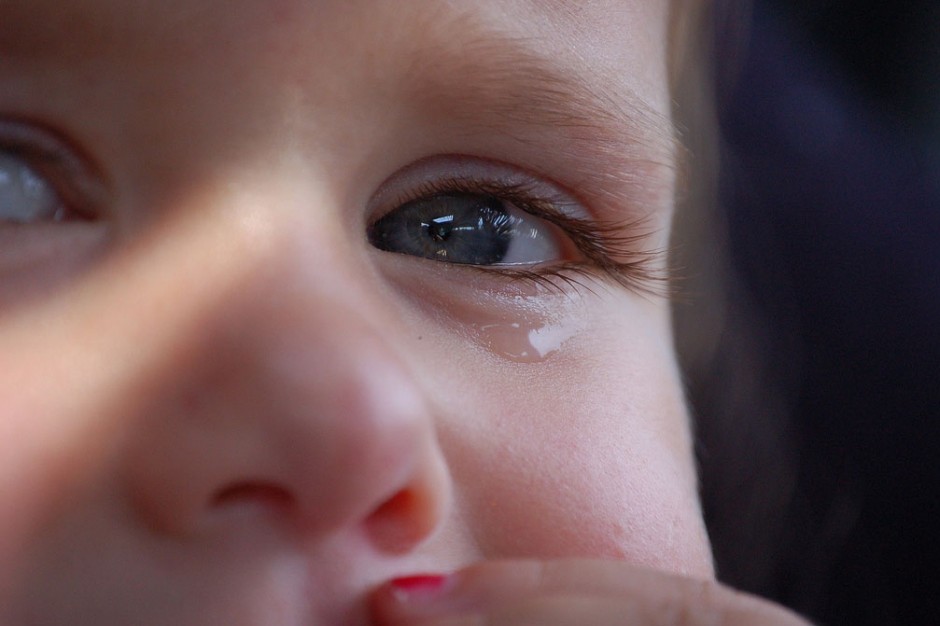 that must be purged? At what point did “defeating” a child so that they are “totally broken” become the goal of Christian parenting?
that must be purged? At what point did “defeating” a child so that they are “totally broken” become the goal of Christian parenting?
Let’s go back to the model of servant leadership set by Jesus who said, “I stand at the door and knock…” (Revelations 3:20) Knock what? Knock humans on their backsides and pin them down while pummelling them until they are utterly defeated? Knock small children around until they are totally broken?
No, of course not. Jesus says, “I stand at the door and knock. If anyone hears my voice and opens the door, I will come in and eat with that person, and they with me.” Jesus doesn’t barge in making demands to prove how big and tough he is. Jesus invites us to open the door of our lives and to invite him in as an honored guest, in return.
Look also at Deuteronomy 30:19 where God shares that it is from him that our ability to choose originates, “I have set before you life and death, blessing and curse; therefore choose life, that you and your descendants may live.” Note that God doesn’t demand that we submit our free, God-given will, our ability to choose, to him. He simply invites us to align our will with his.
And look at James 4:8, “Draw near to God and He will draw near to you.” God doesn’t chase us down, “sit on” us, or “use whatever force is necessary” (see Pearl quote above) to strong-arm us into submission. He reaches out to us and inspires us and opens his arms to us, inviting us into the safety and comfort and wholeness of a relationship with Love Himself.
Our will is a gift, an opportunity to choose right from wrong, and the vehicle through which God calls us to choose his Son. Without this amazing and wonderful gift, without the freedom to use our free will, Jesus’ suffering and death on the Cross would be pointless.
Sin is a moot point in light of the grace we’ve been given. Grace is the point. The whole point. Everything leading up to the Cross pointed to the Cross, everything was settled on the Cross, and on the Cross in the outstretched 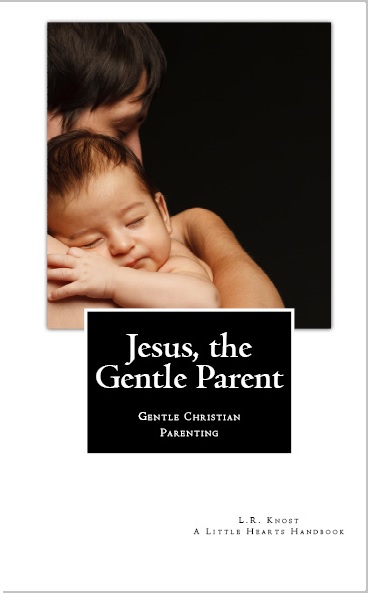 arms of Jesus grace was born. Sin only matters in the sense that when we voluntarily choose to stay within the boundaries God has given us, we are closer to him, more in-tune with him, and more aligned with his will. He does not stray from us, not ever. But we do stray from him. We are human, and as humans we learn by doing, by experiencing, by exercising our free will as we stretch and grow and discover and make mistakes and overcome life and are overcome by life, each trial and failure and success a learning experience. God doesn’t chase us down and crash through the walls we’ve put up and drag us back to repentance. He waits for us, always available, always forgiving, always loving us unconditionally, but never giving up as he calls out to us, inviting us gently to himself.
arms of Jesus grace was born. Sin only matters in the sense that when we voluntarily choose to stay within the boundaries God has given us, we are closer to him, more in-tune with him, and more aligned with his will. He does not stray from us, not ever. But we do stray from him. We are human, and as humans we learn by doing, by experiencing, by exercising our free will as we stretch and grow and discover and make mistakes and overcome life and are overcome by life, each trial and failure and success a learning experience. God doesn’t chase us down and crash through the walls we’ve put up and drag us back to repentance. He waits for us, always available, always forgiving, always loving us unconditionally, but never giving up as he calls out to us, inviting us gently to himself.
When it comes to parenting, we all know that some of God’s children are created with a remarkable strength of will, a powerful drive to explore and discover, an insatiable thirst for knowledge, an incredible need to know and be known, and with more energy than can be contained in a small body. Their frequent challenges to ‘the way things are’ can feel overwhelming to the most patient of parents, and their sometimes epic meltdowns when all of that extreme energy explodes out of their small frames can act like a tidal wave of emotion that gets everyone swept up in the maelstrom. These children who are given the gift of an indomitable spirit have all of the amazing characteristics of future world leaders, but their gifts need to be grown and nurtured and developed, not contained, stunted, and crushed.
A popular child-training book by Dr. James Dobson, The New Strong-Willed Child, has a markedly different approach to parenting strong-willed children, however: “Some strong-willed children absolutely demand to be spanked, and their wishes should be granted. . . two or three stinging strokes on the legs or buttocks with a switch are usually sufficient to emphasize the point, ‘You must obey me.’” In addition to the disputable Biblical interpretations of the ‘rod’ verses and the misuse of the word ‘obey’ in translating from the original language of the Bible, there is a fundamental difference in philosophies revealed here. In the positive parenting approach, children are born perfect and need only to be guided through the normal stages and behaviors of childhood. In the punitive parenting approach, children are born sinful and must be forced to submit to superior authority.
On a purely logical level, why would we fight a child for control when what we really want is for them to be in control of themselves? Why not, instead, help them to process those big emotions and learn how to direct their own energy and develop their own ability to control themselves? Why not follow Jesus’ example and invite our strong little future leaders to walk alongside us in tandem to learn and grow and discover together for the oh-so-brief season of their childhood?
On a practical level, though, the question is, “How can we partner with our children in positive and peaceful ways to guide them gently and effectively?”
Here is a chapter from The Gentle Parent: Positive, Practical, Effective Discipline to get you started on your gentle journey with your own little future leaders:
‘The Gift of a Strong-Willed Child’
There are some children who are born into the world with the incredible life-gift of a strong will and an indomitable spirit. These children are often deeply misunderstood, and there are rows of books lining bookstore shelves with instructions about how to break their will, how to subdue their spirit, how to force their obedience. What an incredible loss of leadership, passion, and insight this world suffers when parents follow these punitive parenting practices. Not only can we parent these gifted children with gentleness and respect, but the gifts we get in return are priceless!
Take a look at some of the common descriptions used when referring to the characteristics of a strong-willed child:
Demanding, Insistent, Stubborn, Bossy, Cocky, Difficult, Challenging, Fixated, Contrary, Rebellious, Defiant
Now look at some of the common characteristics of adults who are world leaders, CEO’s, entrepreneurs, innovators, world-class athletes, and the like:
Decisive, Determined, Persistent, Authoritative, Confident, Valiant, Gutsy, Committed, Resourceful, Nonconforming,Bold
Note that the characteristics are the same, but the characterizations are negative when applied to a child and positive when applied to an adult.
Other characteristics of strong-willed children that coincide with the characteristics of adult leaders in their fields are:
- They are typically highly creative and intelligent.
- They are usually passionate and intense in their interests and beliefs.
- They often have an insatiable need to know ‘why.’
- They typically learn by doing.
- They tend to have an intense need to test the status quo.
- They are typically highly perfection-oriented, but often that is focused on their expectations of themselves instead of others.
- They tend to need high levels of validation.
- They usually have an intense need to be heard.
- They often have a strong need for emotional safety.
- They tend to be resistant to change unless they feel like they have some control over the change.
- They are often highly sensitive.
- They are typically intensely focused on their latest project or interest.
- They tend to be conscientious and highly committed.
- They are usually intensely independent.
While there’s no doubt that it’s a challenge having a child who seems to challenge everything, there are ways to work with them rather than against them to preserve and nurture their unique gifts. Maintaining a healthy parent/child relationship is vital as you work to find a balance between setting limits with your richly spirited child while not limiting their freedom to stretch and grow and develop into the person they were created to be.
The key to preserving your trust relationship with your child is remaining calm and present and supportive, even while setting and maintaining reasonable boundaries. It is helpful to remember that the most strong-willed children tend to be the ones who identify the most strongly with their parents. So instead of viewing their seemingly constant challenges as defiance or attempts to thwart authority, work to parent from a place of understanding that your strong-willed child is actually on a discovery mission and is doing endless ‘research’ on you by testing and retesting and digging and chiseling to discover all of your quirks and foibles and ups and downs and strengths and weaknesses. This kind of testing isn’t negative unless you make it into a battle of wills instead of responding with gentle, respectful guidance. Taking this stance will help you to keep from seeing the challenges as personal insults and, instead, see the challenges as attempts to learn and grow and understand.
There is no doubt, though, that parenting a child with the gift of a strong will is a constant exercise in patience and self-regulation. The personal growth you will experience is invaluable as you seek to parent with empathy and wisdom and compassion, but it can be draining and will often stretch you far, far out of your comfort zone. Knowing that and being prepared for it will help you cope with the inevitable stresses, and being ready ahead of time with some specific strategies for handling the challenges will help you to respond calmly and effectively.
This is a good place to revisit the Three C’s of gentle discipline—Connection, Communication, and Cooperation.
Connection ~ Maintaining a secure connection with your spirited child is vital. It is the springboard from which all of your interactions with your child will originate, and it is the touchstone to which you will both return, again and again and again, when your relationship gets strained and stained and stretched.
- Play word games, board games, rough-and-tumble outdoor games, silly face in the mirror games. Play is the language of childhood, so make sure to speak your child’s language every day.
- Laugh together. Humor is an undervalued parenting tool. But it lowers defenses, inspires smiles, brings people together, and reconnects hearts.
- Read storybooks, chapter books, travel brochures, encyclopedias, anything that will inspire you to dream together, talk, plan, get excited, share interests.
- Focus more on who your child is than on what your child does. Remember, you’re growing a person, not fixing a problem. So make sure to spend time getting to know the person, not just the child. It doesn’t have to cost anything. Just walk together, talk together, share ice cream cones, spot shapes in the clouds, and enjoy each other.
Communication ~ Children have their own ‘inner world’ of thoughts and plans and problems and worries and hopes and dreams that are occupying their time and attention, so a lack of cooperation is often simply the result of having a different agenda than we do. Getting some insight into that ‘inner world’ is key in guiding and growing them respectfully.
- Listen with your heart. Listen ‘between the lines’ to what your child is communicating through their behavior. Listen and listen and listen some more. That is always, always the first step in communicating with your child.
- Reflect, connect, and redirect. Reflect what you hear, whether it’s communicated by your child’s behavior or their words. This not only validates their emotions and lets them know that you hear and understand them, but it also helps them to understand their own emotions. For instance, if your child is upset that he can’t have a cookie after brushing his teeth for bedtime, try saying, “I hear you. You’re upset because you want a cookie.” Then reestablish your connection, “I like cookies, too!” and offer a solution, “How about we go pick out the two best cookies and put them in a special container that we can take to the park in the morning?”
- Don’t take non-compliance as a personal insult. A strong-willed child is very much their own person with their own agenda. Focus on inviting cooperation instead of demanding obedience. Whether it’s staying in bed or cleaning up or whatever the issue, make it a team effort and come up with a game plan ahead of time. For example, you could say, “You seem to be having trouble staying in bed at night. What do you think would help you to be more ready to go to sleep when it’s time for bed?” or “It’s important to pick up our things so they don’t get broken, let’s put on the timer and work together for ten minutes and see who gets the most picked up.”
- Make a firm commitment not to resort to punishments to control behavior. The resentment that comes from being punished absolves children in their own minds of responsibility. It doesn’t teach them responsibility, and resentment can actually cause a lot of the behaviors you are trying to avoid.
- Communicate daily, outwardly to your child and inwardly to yourself, the positive aspects of your child’s personality. When the focus is on ‘fixing’ a child, they get the message that they are somehow broken, and that is not a healthy self-image to take into adulthood.
- ‘No’ is not a complete thought. It is an imperative, a command. It doesn’t teach. It tells. If you want your child to learn to think like an adult, take the time to explain your adult thinking.
- Remember that children, especially when they are upset, open ‘conversations’ through their behavior, and it’s up to us, the only adults in the relationship, to gently guide them toward continuing those conversations verbally as well as equipping them with the resources to be able to do so.
- Also keep in mind that the social mores of rudeness simply aren’t inborn and don’t apply to early interactions with our children. They are learned by imitating how we as parents behave. Politeness is a heart issue that cannot be imposed by the will of another unless we want it to only be an external façade instead of a heartfelt courtesy. Helping your strong-willed child learn to speak kindly means speaking kindly to your child as well as offering guidance when they’ve been rude such as saying, “That is not a nice tone of voice” or “That isn’t a kind thing to say” and then offering a do-over “Can you try saying that to me again more nicely? I’ll always try my best to be nice to you, and I would like you to try to do the same for me.”
Cooperation ~ Always keep at the forefront of your parenting goals that you are seeking thoughtful cooperation, not mindless compliance. That way you will remember to treat your child as a thoughtful individual with ideas and needs and feelings of their own instead of a mindless drone there to do your bidding.
- Set clear limits and explain them in age-appropriate terms. Remember, if you want to invite cooperation, you have to actually issue the invitation to cooperate!
- Limit the number of limits. Spirited children are often stressed children simply because of their own intense emotions and reactions to things, so set them up for success by keeping your limits few and clear and by maintaining them consistently.
- Make sure to let your child have a voice in determining the limits so they feel like they have some control over their lives and so they feel some ownership over the limits.
- Brainstorm together ways of helping everyone to work together. Some ideas are to come up with hand signals or words that remain your little secret codes to indicate when it’s time to leave the park or to do homework or to dial the activity level or noise volume down a few notches.
- Invite cooperation by creating daily routines together. Don’t be surprised if your child ends up being the one who is a stickler for following the routine, even to the point of nagging you to follow it. These gifted children tend to be all-in, fully focused and committed, and they’ll expect you to be the same!
- Cooperate with your child’s needs and personality by working with them rather than against them. For instance, if you know that your child has a hard time leaving a project, give them plenty of time to find a good stopping point when you need them to leave it for a while. Or if you know that your child has a hard time following directions at bedtime, try writing or drawing the tasks that need to be done (i.e. toothbrushing, pajamas, etc.) on ping-pong balls and put them in a small ‘bedtime jar’ so your child can feel some control over their routine as they independently pick out the balls one by one for a ‘surprise’ nighttime order of tasks or take them all out and decide what order to do them in themselves.
- If you are already locked in a head-to-head power struggle, put away your boxing gloves so your child will (eventually!) feel safe putting away theirs. When you battle with your child, you may win a skirmish or two, but you will lose the treasure…your trust relationship. Putting away the gloves means slowing down, breathing through your own emotions, and finding a way to work through the issue together. Remember, you’re the adult in the relationship, but that doesn’t give you the right to overpower your child; it gives you the responsibility to empower your child. That involves modeling the tools of diplomacy—communication, cooperation, compromise—that you want your child to stock in their own emotional toolkit.
Remember, the children who come into the world with their ‘boxing gloves on’ so to speak are often the ones who become the biggest world changers. It’s not easy raising these little world-changers, I know (Believe me, I know. Two of my six are world-changers-in-the-making!), but the rewards are phenomenal!
“The Lord’s loving-kindnesses indeed never cease, for his compassions never fail.”
Lamentations 3:22
Related posts:
Spare the Rod: The Heart of the Matter
Jesus, the Gentle Parent: Gentle Christian Parenting
Tattered Tapestries: Weaving Trust Through the Chaos
Fear Doesn’t Lead to Faith: Becoming Your Child’s Safe Place
Where Did You Learn Love, Child?
Gentle Journeys: A Book Club for a New Generation
Practical, Gentle, Effective Discipline
 Award-winnning author, L.R.Knost, is the founder and director of the children's rights advocacy and family consulting group, Little Hearts/Gentle Parenting Resources, and Editor-in-Chief of Holistic Parenting Magazine. Books by L.R.Knost include Whispers Through Time: Communication Through the Ages and Stages of Childhood ; Two Thousand Kisses a Day: Gentle Parenting Through the Ages and Stages ; The Gentle Parent: Positive, Practical, Effective Discipline ; and Jesus, the Gentle Parent: Gentle Christian Parenting the first four books in the Little Hearts Handbook gentle parenting series, and children’s picture books Petey’s Listening Ears and the soon-to-be-released Grumpykins series.
Award-winnning author, L.R.Knost, is the founder and director of the children's rights advocacy and family consulting group, Little Hearts/Gentle Parenting Resources, and Editor-in-Chief of Holistic Parenting Magazine. Books by L.R.Knost include Whispers Through Time: Communication Through the Ages and Stages of Childhood ; Two Thousand Kisses a Day: Gentle Parenting Through the Ages and Stages ; The Gentle Parent: Positive, Practical, Effective Discipline ; and Jesus, the Gentle Parent: Gentle Christian Parenting the first four books in the Little Hearts Handbook gentle parenting series, and children’s picture books Petey’s Listening Ears and the soon-to-be-released Grumpykins series.
May 31, 2014 | Categories: abuse, aggression, anxiety, Bible, books, bullying, childhood, children, Christian, Christian parenting, communication, defiance, discipline, fatherhood, fear, gentle discipline, gentle parenting, grace-based discipline, hitting, Jesus, lashing out, motherhood, parenting guide, positive discipline, positive parenting, rebellion, spanking | Tags: Bible, Biblical parenting, breaking their will, discipine, Dobson, free will, Godly parents, Jesus, Michael Pearl, parenting, spanking, The Strong Willed Child, To Train Up a Child, Williams | 8 Comments »
[Excerpt from Whispers Through Time: Communication Through the Ages and Stages of Childhood by L.R.Knost. Two Thousand Kisses a Day: Gentle Parenting Through the Ages and Stages, The Gentle Parent: Positive, Practical, Effective Discipline, and Jesus, the Gentle Parent: Gentle Christian Parenting also available on Amazon and through other major retailers.]
~~~~~~~~~~~~~~~~~~~~~
“By words we learn thoughts, and by thoughts we learn life.”
Jean Baptiste Girard
I love words. I love language. I love playing with old, staid quotes and classic literature titles, stories and  legends, clichés and adages, and weaving them into unique or humorous settings.
legends, clichés and adages, and weaving them into unique or humorous settings.
But along with loving word play, I’m very aware of the power of language. Words can bring life, “It’s a boy!” and love, “I do!” and words can bring death, “I’m sorry. There’s nothing more we can do.”
When it comes to raising children, the power of words cannot be overestimated. From how the labels we use influence our own perceptions of our children and their perceptions of themselves to how children’s immature grasp of language limits their understanding and responses, words exercise immense power over the life of a child.
Just as important as being careful of the labels we use and having an understanding of language development in young children, though, or even more so, is being aware of the propensity for stressed and angry adults to ‘power-up’ on children and use language as a weapon. The lash of the tongue on the heart of a child can have devastating and lasting consequences.
“You stupid little idiot!”
“Can’t you do anything right?”
“Why did I ever have you?”
“I hate my life!”
“You are totally useless!”
Words live and breathe and grow in our hearts until they either bear life-giving fruit ~ comfort, security, confidence…or fester into infectious, oozing wounds ~ despondency, anxiety, rage.
There is great truth to the belief that bullying begins at home. Children learn what they live. Just as violence begets violence, so angry parents tend to result in angry children, and parents who ridicule tend to produce sarcastic children, and critical parents tend to generate negative children, and on and on.
Whether the children end up the bully or the bullied, aggressive with their peers or with themselves, cutting down others or cutting themselves, the fact is that hurting people hurt people, and children raised with violence or condemnation in whatever form they take are hurting people.
Words matter. They matter desperately…as desperate as a five-year-old is to hear she’s good, as desperate as a ten-year-old is to hear he’s smart, as desperate as a fifteen-year-old is to hear she’s valuable.
The truth is that we all make mistakes. We all say the wrong thing sometimes. We get angry and frustrated and overwhelmed and verbally lash out at these tiny, impetuous, energetic, often incomprehensible, but always vulnerable little people we’ve been entrusted with the care and raising of. And often we don’t apologize because we don’t want to appear weak or to admit we’ve made a mistake or we’d rather just let it be or it doesn’t even occur to us that we should apologize to a child. But words can heal, too, and an apology is a necessary step in the healing process.
But when verbal blows go untended, souls become scarred. When lashing out becomes the norm, damages begin to mount. And when children with battered souls grow into adults, the vicious cycle often continues in the form of domestic violence, substance abuse, or other destructive behaviors.
Parents, choose your words wisely, carefully, thoughtfully. In the same way that violence begets violence and anger begets anger, kindness begets kindness and peace begets peace. Sow words of peace, words that build, words that show respect and belief and support. Those are the seeds of a future filled with goodness and hope and compassion, and aren’t those the things we really want for our children, after all? [end excerpt]
Related posts:
The Color of Change
When Toddlers Become Teens
Backtalk is Communication…LISTEN
The Gift of a Strong-Willed Child
The Problem with Punishment
12 Steps to Gentle Parenting
Bridge Over Troubled Waters~Parenting a ‘Problem’ Child
Rethinking Tattling
Fear Doesn’t Lead to Faith: Becoming Your Child’s Safe Place
Spare the Rod: The Heart of the Matter
 Award-winnning author, L.R.Knost, is the founder and director of the children's rights advocacy and family consulting group, Little Hearts/Gentle Parenting Resources, and Editor-in-Chief of Holistic Parenting Magazine. Books by L.R.Knost include Whispers Through Time: Communication Through the Ages and Stages of Childhood ; Two Thousand Kisses a Day: Gentle Parenting Through the Ages and Stages ; The Gentle Parent: Positive, Practical, Effective Discipline ; and Jesus, the Gentle Parent: Gentle Christian Parenting the first four books in the Little Hearts Handbook gentle parenting series, and children’s picture books Petey’s Listening Ears and the soon-to-be-released Grumpykins series.
Award-winnning author, L.R.Knost, is the founder and director of the children's rights advocacy and family consulting group, Little Hearts/Gentle Parenting Resources, and Editor-in-Chief of Holistic Parenting Magazine. Books by L.R.Knost include Whispers Through Time: Communication Through the Ages and Stages of Childhood ; Two Thousand Kisses a Day: Gentle Parenting Through the Ages and Stages ; The Gentle Parent: Positive, Practical, Effective Discipline ; and Jesus, the Gentle Parent: Gentle Christian Parenting the first four books in the Little Hearts Handbook gentle parenting series, and children’s picture books Petey’s Listening Ears and the soon-to-be-released Grumpykins series.
May 25, 2014 | Categories: abuse, adolescence, aggression, anxiety, bullying, character, childhood, children, communication, gentle parenting, lashing out, middle childhood, peer pressure, positive parenting, praise, preschooler, teens, toddler | Tags: adolescents, bullying, discipline, parenting, preschoolers, teens, tweens | Leave A Comment »
 [Reprinted from The Gentle Parent: Positive, Practical, Effective Discipline by L.R.Knost. Whispers Through Time: Communication Through the Ages and Stages of Childhood and Two Thousand Kisses a Day: Gentle Parenting Through the Ages and Stages also available on Amazon and through other major retailers.]
[Reprinted from The Gentle Parent: Positive, Practical, Effective Discipline by L.R.Knost. Whispers Through Time: Communication Through the Ages and Stages of Childhood and Two Thousand Kisses a Day: Gentle Parenting Through the Ages and Stages also available on Amazon and through other major retailers.]
~~~~~~~~~~~~~~~~~~~~~
The teen years can hit a family with the force of a hurricane. Parents who practice control-based parenting and have felt confident in their control over their children up until this point often find themselves lost, dazed, and bewildered, entangled in a parenting morass of their own making. The truths they discover shock them and leave them vulnerable and defenseless in the face of outright or passive mutiny:
- Hitting doesn’t lead to hugging. Just ask the mother struggling with her teenage daughter who had become withdrawn around the age of twelve or thirteen, often spending hours in her room and refusing to engage with the rest of the family. The mother recognized that there was a problem at the time, but interpreted it as laziness, selfishness, and rebellion and responded with correction instead of connection. The mother says, “My daughter won’t accept discipline given in love anymore, and I don’t know how to control her behavior.” The ‘discipline given in love’ her daughter refused to accept was being spanked with a paddle wielded by a parent who then demanded an apology from the child for her behavior, followed by a hug. This mother is discovering that, now that her daughter has reached her teen years, she no longer accepts the hitting, and she no longer accepts the hugs, either.
- Lectures don’t lead to learning. Just ask the father who complained that every time he sat his son down to read him the riot act for something, he could see his son’s eyes glaze over as the teen retreated to an inner world. The father would repeatedly demand that his son pay attention, and his son would then quote his lecture verbatim, but nothing worked to change his son’s behavior. The father shared, “I don’t know what to do. How can I control my son if I can’t reach him?” What this father is discovering is that lecturing instead of listening is a one-way street that leads nowhere.
- Coercion doesn’t lead to cooperation. Just ask the mother who was so frustrated with her son’s inability to finish his math homework that she began to take his things and hold them as ransom to try to force him to cooperate. She emptied his room piece by piece, day after day, until she’d literally taken away everything he owned, including every article of clothing except for the clothes on his back. After six weeks of her son wearing the same clothes and sleeping on the floor, she said, “I don’t know what else I can take away from him. He doesn’t have anything left! How can I control him now?” What this mother is finding is that you can’t force cooperation and children outgrow coercion just like they outgrow clothing.
- Ridicule doesn’t lead to respect. Just ask the father who made his daughter post on Facebook that she had lied to her parents about her screen-time and couldn’t be trusted to have a laptop, so she wouldn’t be online for a month. The father was infuriated to then discover that his daughter was using her friends’ computers to go online, so he made her call every one of her friends’ parents and explain why she wouldn’t be visiting for the next month. When the father later found out his daughter was using the computers at the library to go online, he made her stand in front of the library with a sign that said, “I’m a liar.” A week later the father found his daughter online in the middle of the night, using a laptop borrowed from a friend. The father says, “What can I do? Every time I find a way to control my daughter, she finds a way around it. How can I make her respect me?” What this father is finding is that you can’t force respect. Ridicule and shame are disrespectful and only breed more disrespect.
What these parents are discovering, and what you may have already discovered yourself as your children have reached adolescence, is that no matter how much you escalate punishments, they won’t work to get your children under your control because one human can never really control another. Yes, you can overpower a small child, and you can use fear and intimidation and manipulation to force children to comply, but only for a season. Once they reach the teen years and their own identity begins to fully emerge, they gain enough separation to realize that they can finally say no to the hitting and threats and manipulations. They may say no with outright rebellion or by withdrawing into passive resistance, but they will say no, and then you are lost because you haven’t built a relationship based on mutual respect and cooperation. You’ve simply spent years forcing your will on a smaller, weaker human.
Can you make changes, even this late in parenting? Yes. Stop hitting, threatening, intimidating, coercing, shaming, and trying to control your child. Wipe the slate clean with a sincere apology, and then start rebuilding your relationship from the ground up:
- Create a foundation of trust by proving yourself trustworthy. That means honoring your word that you won’t punish or manipulate your teen to try to control them, no matter what.
- Sacrifice your own hopes and dreams for your teen and support their hopes and dreams. Will they make mistakes? Yes. That’s part of life. Let them make the mistakes without repercussion from you, and help them through the natural results of those mistakes so they will know they can count on you when life hurts.
- Set limits with your teen instead of for your teen. Ask their opinion about curfews and relationships and housework. Tell them that it’s an honor system from this point on, no punishments, and ask them how you can help them to honor the limits they’ve helped set.
- Remember that, while your teen is rapidly approaching adulthood, they are still a child and still need guidance. Don’t disconnect (i.e. give up) and just let your teen figure things out for themselves. Yes, they do need to try and fail and try again so they can learn from their mistakes, but that doesn’t mean they don’t need you. Your role at this point is supportive as you stay in-tune and available and help them to process all of the big transitions and emotions and events that happen in adolescence. Walk them through the problem-solving steps (see The Gentle Parent: Positive, Practical, Effective Discipline, Chapter Twenty-Five) as many times as they need you to so that they can learn how to become problem solvers themselves.
- If they backtalk, LISTEN (see The Gentle Parent: Positive, Practical, Effective Discipline, Appendix B). If they struggle with homework, help them. If they lie, forgive them and work with them to come to a place where they feel safe to be truthful. If they break curfew, ask them why and work with them to sort out the problem.
- Memorize these words, “I’m here. I hear you. How can I help?” They encapsulate the Three C’s of gentle parenting—Connection. Communication. Cooperation. Use them every day to rebuild your relationship.
The thing to remember is that you are the only adult in the relationship for the time being, so be the first one to listen, the first one to forgive, the first one to apologize, the first one to understand, the first one to back down and try to find another way when the going gets tough. Before you know it, your teen will be an adult, just like you… Just. Like. You. Make sure the ‘you’ they see is the ‘you’ that you want them to become.
Related posts:
When Toddlers Become Teens
The Color of Change
Backtalk is Communication…LISTEN
The Gift of a Strong-Willed Child
The Problem with Punishment
12 Steps to Gentle Parenting
Bridge Over Troubled Waters~Parenting a ‘Problem’ Child
Why Whining is a Win!
Rethinking Tattling
Two Thousand Connection Points a Day: Attachment Parenting Beyond Infancy
 Award-winnning author, L.R.Knost, is the founder and director of the children's rights advocacy and family consulting group, Little Hearts/Gentle Parenting Resources, and Editor-in-Chief of Holistic Parenting Magazine. Books by L.R.Knost include Whispers Through Time: Communication Through the Ages and Stages of Childhood ; Two Thousand Kisses a Day: Gentle Parenting Through the Ages and Stages ; The Gentle Parent: Positive, Practical, Effective Discipline ; and Jesus, the Gentle Parent: Gentle Christian Parenting the first four books in the Little Hearts Handbook gentle parenting series, and children’s picture books Petey’s Listening Ears and the soon-to-be-released Grumpykins series.
Award-winnning author, L.R.Knost, is the founder and director of the children's rights advocacy and family consulting group, Little Hearts/Gentle Parenting Resources, and Editor-in-Chief of Holistic Parenting Magazine. Books by L.R.Knost include Whispers Through Time: Communication Through the Ages and Stages of Childhood ; Two Thousand Kisses a Day: Gentle Parenting Through the Ages and Stages ; The Gentle Parent: Positive, Practical, Effective Discipline ; and Jesus, the Gentle Parent: Gentle Christian Parenting the first four books in the Little Hearts Handbook gentle parenting series, and children’s picture books Petey’s Listening Ears and the soon-to-be-released Grumpykins series.
February 26, 2014 | Categories: adolescence, aggression, anxiety, bullying, communication, defiance, discipline, fear, gentle discipline, gentle parenting, grace-based discipline, middle childhood, positive discipline, positive parenting, rebellion, spanking, stress, teens | Tags: adolescence, adolscents, aggression, anger, fatherhood, motherhood, parenting, rebellion, spanking, teens | 1 Comment »
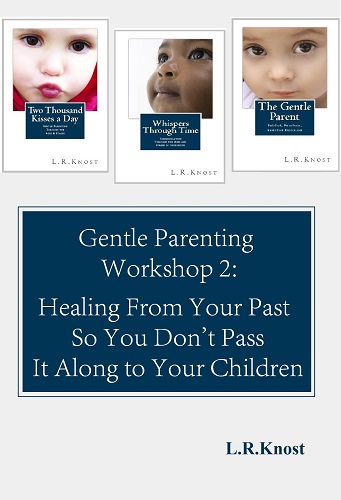 Gentle Parenting Workshop 2: Healing from Your Past so You Don’t Pass it Along to Your Children will help you work through the steps of recovery from a painful past, leading you on a journey of healing and forgiveness, of unloading negative emotional baggage into the past where it belongs instead of unloading it onto your children and passing it along to the next generation, and of renewal to open the pathway to a more peaceful and gentle approach to parenting.
Gentle Parenting Workshop 2: Healing from Your Past so You Don’t Pass it Along to Your Children will help you work through the steps of recovery from a painful past, leading you on a journey of healing and forgiveness, of unloading negative emotional baggage into the past where it belongs instead of unloading it onto your children and passing it along to the next generation, and of renewal to open the pathway to a more peaceful and gentle approach to parenting.
“The key to freedom is forgiveness. Forgiveness drains the past of its power to drain the present of its peace. Keep in mind, though, that it’s a journey, an ongoing life-process, a day-by-day decision, not a destination.
Forgiving someone doesn’t mean telling them that hurting us was okay. It means telling ourselves that it’s okay to stop hurting. It doesn’t mean we have to trust them again. It means we can learn to trust ourselves again because we deserve it. It doesn’t mean we have to give them a free pass back into our lives. It means we are free to take our lives back again. Forgiving is letting the hurts of the past go so that we can move freely into the future.”
The Gentle Parenting Workshop 2 walks you through five stages of healing and emotional freedom, including multiple action steps for you to take along the way from making the decision to change to identifying your triggers to forgiving your own mistakes of the past to coping when life hits hard.
“When a tragedy strikes in the form of a death or a life-changing illness or an accident, or when our lives are suddenly turned upside-down due to a divorce or other major life event, we need to grieve the loss of our old lives, our old ‘normal,’ our younger, more carefree, and unwounded selves, so that we can embrace our new normal and learn to live fully and joyfully again. Just as if a person had hurt us, we are hurting humans and we need to take the time and make the investment in self-care to work through the hurt and emerge a wiser, more mature, and more compassionate human.”
Remember, it’s easier to grow heart-whole children than it is to repair broken-hearted adults. Continuing to pass pain from one generation to the next is costly, but giving your children the gift of a happy childhood is truly priceless.
Gentle Parenting Workshop 2: Healing from Your Past so You Don’t Pass it Along to Your Children ~ .99 cents on Amazon for Kindle, to download onto your computer, iPhone or other smart phone, or iPad
Other gentle parenting resources you may find helpful:
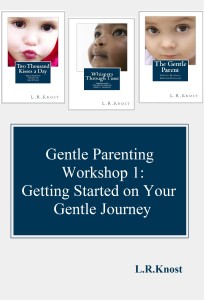 Gentle Parenting Workshop 1: Getting Started on Your Gentle Journey
Gentle Parenting Workshop 1: Getting Started on Your Gentle Journey
The Gentle Parenting Workshop series from award-winning author, L.R.Knost, is a companion series to her best-selling parenting books, ‘Two Thousand Kisses a Day,’ ‘Whispers Through Time,’ and the newest release, ‘The Gentle Parent.’ This first workshop in the series, ‘Gentle Parenting Workshop 1: Getting Started on Your Gentle Journey,’ will help you set your gentle parenting goals, identify specific parenting problems, and target practical solutions to help you along on your journey to gentle parenting.
 Two Thousand Kisses a Day: Gentle Parenting Through the Ages and Stages
Two Thousand Kisses a Day: Gentle Parenting Through the Ages and Stages
Calm, Reassuring, Likable ~ Written in L.R.Knost’s signature easy-to-read and conversational style, ‘Two Thousand Kisses a Day’ offers an overview of gentle parenting from birth through young adulthood along with concrete suggestions and insights into how to implement gentle parenting in each stage of childhood. Her seasoned and practical approach based on extensive child development research and years of parent mentoring as well as over twenty-five years of parenting her six children is as likable as it is reassuring. Parents with children of any age will find this information-packed book with its bite-sized chapters and practical approach to parenting a helpful and encouraging addition to their home library, as well as a welcome gift for new or struggling parents. ~The Parenting Review
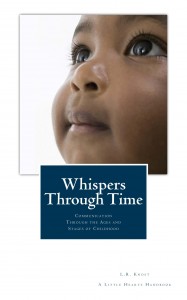 Whispers Through Time: Communication Through the Ages and Stages of Childhood
Whispers Through Time: Communication Through the Ages and Stages of Childhood
Sweet, Funny, Insightful ~ Award-winning ‘Whispers Through Time’ by L.R. Knost is destined to be a dog-eared favorite, passed down from generation to generation. L.R. Knost shows parents how to find their own answers for their own children and their own families in this guidebook as she challenges conventional thinking with a wisdom born of experience and a healthy dose of research to back it up. Written with the same unique blend of sweetness and humor, grit and honesty, reassurance and insight that made L.R. Knost’s first book, ‘Two Thousand Kisses a Day: Gentle Parenting Through the Ages and Stages,’ a best-seller, ‘Whispers Through Time’ has become a runaway hit in its own right. ~The Parenting Review
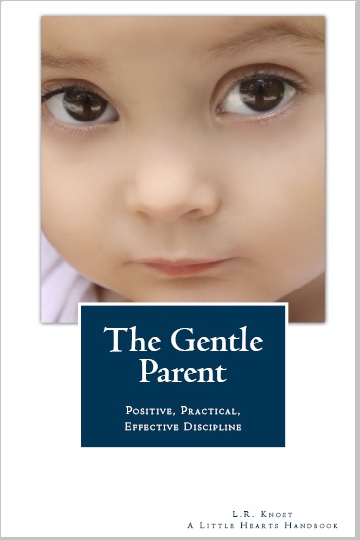 The Gentle Parent: Positive, Practical, Effective Discipline
The Gentle Parent: Positive, Practical, Effective Discipline
Relaxed, Reassuring, Practical ~ Written by L.R.Knost, best-selling, award-winning author of ‘Two Thousand Kisses a Day’ and ‘Whispers Through Time,’ ‘The Gentle Parent: Positive, Practical, Effective Discipline’ shares the simple secrets of a peaceful, happy home in the Three C’s of gentle discipline–Connection, Communication, and Cooperation. In her signature relaxed and poetic style, L.R.Knost gently guides parents through the steps of applying the Three C’s in real-life scenarios from tantrums to defiance to parenting a strong-willed child to healing a broken parent/child relationship. Practical and proven, this newest installment in the Little Hearts Handbook parenting series will be tucked into diaper bags, kept handy on nightstands, and shared with good friends for its research-backed, experience-based, and humor-rich insights, ideas, and inspiration. ~The Parenting Review
 Award-winnning author, L.R.Knost, is the founder and director of the children's rights advocacy and family consulting group, Little Hearts/Gentle Parenting Resources, and Editor-in-Chief of Holistic Parenting Magazine. Books by L.R.Knost include Whispers Through Time: Communication Through the Ages and Stages of Childhood ; Two Thousand Kisses a Day: Gentle Parenting Through the Ages and Stages ; The Gentle Parent: Positive, Practical, Effective Discipline ; and Jesus, the Gentle Parent: Gentle Christian Parenting the first four books in the Little Hearts Handbook gentle parenting series, and children’s picture books Petey’s Listening Ears and the soon-to-be-released Grumpykins series.
Award-winnning author, L.R.Knost, is the founder and director of the children's rights advocacy and family consulting group, Little Hearts/Gentle Parenting Resources, and Editor-in-Chief of Holistic Parenting Magazine. Books by L.R.Knost include Whispers Through Time: Communication Through the Ages and Stages of Childhood ; Two Thousand Kisses a Day: Gentle Parenting Through the Ages and Stages ; The Gentle Parent: Positive, Practical, Effective Discipline ; and Jesus, the Gentle Parent: Gentle Christian Parenting the first four books in the Little Hearts Handbook gentle parenting series, and children’s picture books Petey’s Listening Ears and the soon-to-be-released Grumpykins series.
February 7, 2014 | Categories: anxiety, attachment parenting, bullying, childhood, Christian parenting, communication, fatherhood, gentle discipline, gentle parenting, grace-based discipline, hitting, lashing out, life, loss, love, motherhood, parenting guide, positive discipline, positive parenting, PPD, pregnancy loss, stillbirth, stress, wise council | Tags: books, discipline, fatherhood, forgiveness, gentle parenting, healing, motherhood, parenting, parenting guide, past, workshops | 7 Comments »
[By L.R.Knost, author of Two Thousand Kisses a Day: Gentle Parenting Through the Ages and Stages, Whispers Through Time: Communication Through the Ages and Stages of Childhood, and The Gentle Parent: Positive, Practical, Effective Discipline available on Amazon and through other major retailers.]
~~~~~~~~~~~~~~~~~~~~~
 In this digital era not only is the world available literally at our fingertips, but a whole new world has opened for predators, pedophiles, perverts, and porn purveyors to assault our children. From predators posing as children to draw children into online relationships and then lure them into real-life danger to pedophiles using the power and anonymity of the internet to traffic in child pornography, our children are at risk in ways that are increasingly difficult to monitor, filter, and protect them from. We are advised to supervise their online activities, but how are we to know that little twelve-year-old Patsy from piano class is actually fifty-year-old Patrick from prison or that fourteen-year-old Joey from the local gym is actually forty-eight-year-old Jimmy from the local jail?
In this digital era not only is the world available literally at our fingertips, but a whole new world has opened for predators, pedophiles, perverts, and porn purveyors to assault our children. From predators posing as children to draw children into online relationships and then lure them into real-life danger to pedophiles using the power and anonymity of the internet to traffic in child pornography, our children are at risk in ways that are increasingly difficult to monitor, filter, and protect them from. We are advised to supervise their online activities, but how are we to know that little twelve-year-old Patsy from piano class is actually fifty-year-old Patrick from prison or that fourteen-year-old Joey from the local gym is actually forty-eight-year-old Jimmy from the local jail?
Talking with our children about the dangers, staying in-tune with them so we recognize when they are stressed or feeling pressured or guilty, working on intentional connection and two-way communication so that our children feel safe and comfortable with us, and maintaining an open, non-judgmental relationship throughout their childhood so that they know they can come to us for help with anything, anytime, anywhere are all vital elements in keeping our children safe from adults who would do them harm.
But what about when it’s other children who are the danger? What about when they are violated by an in-real-life friend? Most of us have had the conversations about stranger-danger and friend-danger and good-touches and bad-touches and our children know what constitutes a personal violation in the physical sense, but do they know what constitutes a violation online and via text and Instagram and other digital media?
Children are increasingly becoming victims of virtual and visual sexual harassment by their own peers and are being bullied either into reciprocating and/or into silence. One such sexual victimization is called ‘sexting’ and has become a huge problem across cultural, ethnic, and gender boundaries. Sexting involves one party taking a graphically nude picture of themselves or of just specific body parts, and texting them to another party. These pictures sometimes get shared from one young person to the next, resulting in ruined reputations and often intense bullying. Children like thirteen-year-old Hope Witsell have been so viciously bullied and horribly humiliated that they have taken their young lives to escape the torture.
Released into this environment by Seventeen Magazine, whose target market is from tweens to teens (ages 12 to 19), is a recent article entitled “What’s with the Pics, Dude?” This incredibly irresponsible article about sexting portrays young males as hapless victims of their own sexual and approval needs and young females as those responsible for redirecting the young men into more appropriate behaviors. The young males are characterized as “needing reassurance that they are desirable” and “fishing for a compliment” and as “figuring you’ll be excited” and “hoping to start a game.” While the young females victimized by the sexting are warned that they may be in danger of “trouble from the law” and that in order to “protect” themselves they should conceal the incident from their parents and from school officials. The damage done to a vulnerable girl who may be humiliated and frightened and looking for guidance as to how to handle the situation, but is told to hide it and to respond with a flirty response and a “cute selfie” instead of cutting off communications with the young man and seeking adult support is incalculable. And the danger the young lady is placed in, whether she may be intimidated into silence or pressured into reciprocation which may then put her in the situation faced by the young victims who committed suicide after their sexting pictures were shared, is very real.
I can only hope that parents are paying attention not only to their children’s online activities and digital interactions, but also to what they are reading so that they can filter the dangers and counteract the misinformation that abounds. Parents, your children have access to the internet, at home or the library or at school or at a friend’s house. And they have access to iPhones and other devices that can take, send, and receive pictures. Be aware. Be in-tune. Be intentional. Focus on maintaining your connection and keeping the lines of communication open. And don’t wait until your child brings these dangers to your attention. Bring them to theirs and let them know you are watching, and you’re available, and you are their safe place.
Related posts:
Backtalk is Communication…LISTEN
The Problem with Punishment
Parenting a Strong-Willed Child
12 Steps to Gentle Parenting
Practical, Gentle, Effective Discipline
The Color of Change
Letter from a Teenage Son
 Award-winnning author, L.R.Knost, is the founder and director of the children's rights advocacy and family consulting group, Little Hearts/Gentle Parenting Resources, and Editor-in-Chief of Holistic Parenting Magazine. Books by L.R.Knost include Whispers Through Time: Communication Through the Ages and Stages of Childhood ; Two Thousand Kisses a Day: Gentle Parenting Through the Ages and Stages ; The Gentle Parent: Positive, Practical, Effective Discipline ; and Jesus, the Gentle Parent: Gentle Christian Parenting the first four books in the Little Hearts Handbook gentle parenting series, and children’s picture books Petey’s Listening Ears and the soon-to-be-released Grumpykins series.
Award-winnning author, L.R.Knost, is the founder and director of the children's rights advocacy and family consulting group, Little Hearts/Gentle Parenting Resources, and Editor-in-Chief of Holistic Parenting Magazine. Books by L.R.Knost include Whispers Through Time: Communication Through the Ages and Stages of Childhood ; Two Thousand Kisses a Day: Gentle Parenting Through the Ages and Stages ; The Gentle Parent: Positive, Practical, Effective Discipline ; and Jesus, the Gentle Parent: Gentle Christian Parenting the first four books in the Little Hearts Handbook gentle parenting series, and children’s picture books Petey’s Listening Ears and the soon-to-be-released Grumpykins series.
January 20, 2014 | Categories: abuse, adolescence, aggression, anxiety, character, teens, wise council | Tags: adolescence, children, instagram, internet, iphones, parenting, pedophiles, pornography, predators, sexting, sexual harassment, social media, teens, texting, victimization | 1 Comment »
[Reprinted from Two Thousand Kisses a Day: Gentle Parenting Through the Ages and Stages by L.R.Knost. Whispers Through Time: Communication Through the Ages and Stages of Childhood and The Gentle Parent: Positive, Practical, Effective Discipline also now available on Amazon and through other major retailers.]
~~~~~~~~~~~~~~~~~~~~~
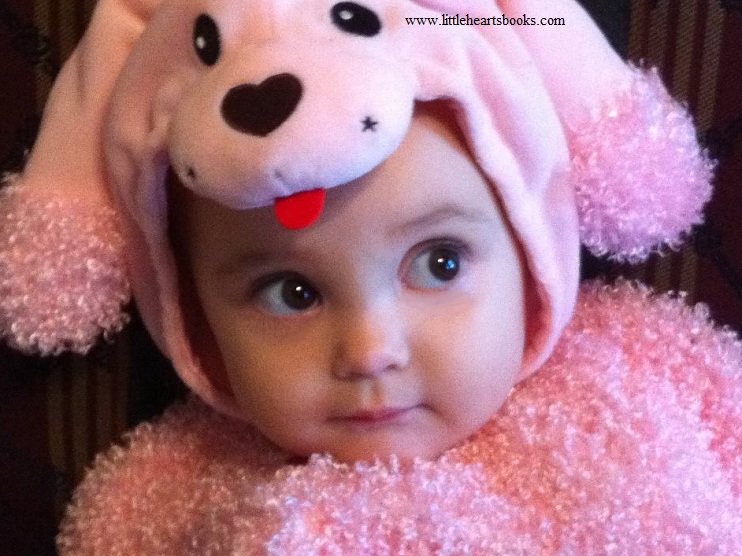 Capri points at the front door every morning and says, “Daddy, go!” Her daddy feels a bit rejected, especially on the weekends when he doesn’t have to go to work and his little girl cries because he won’t leave!
Capri points at the front door every morning and says, “Daddy, go!” Her daddy feels a bit rejected, especially on the weekends when he doesn’t have to go to work and his little girl cries because he won’t leave!
When Daddy and Luca play tickle monsters after bathtime, Mommy tries to join in, but Luca grabs Mommy’s hand and drags her back to her computer chair. Her mommy feels like she’s just the parent workhorse while Daddy gets to be the playmate.
Micah cries and yells, “No-no, Daddy!” when Daddy tries to help with bedtime. Daddy feels like he’s missing out on some of the most important memory-making parts of his little guy’s childhood.
While these parents’ feelings are, of course, valid, the rejection they are feeling is actually a misinterpretation of their children’s actions. Small children are creatures of habit. They’ve only recently arrived in this world and everything is strange and new and big and loud and confusing, so it makes sense that they find comfort and security in repetition and routine. That’s the reason they ask us to read the same book to them over and over and…well, you get the idea.
As they begin to learn and grow, they categorize things in order to understand them. That’s why right at first every animal is a ‘kitty’ and every drink is ‘juice.’ This same process of learning through categorization applies to relationships, as well. Children are constantly observing and studying their parents and the roles each of them play, and then using that information to construct a mental ‘schematic’ of their world.
If a child is accustomed to one parent doing the bedtime routine while the other is busy cleaning up after dinner, a sudden change in that routine may disrupt the little one’s schematic, and they will often resist or have a meltdown.
Understanding that it is the break in routine, the unexpected happening when a small child has settled in their mind what the ‘expected’ is, that is at the root of the issue can help a parent to overcome their feelings of rejection and focus on working toward a solution in a way that meets their child’s security needs.
Here are five ideas to try if you or your partner are a parent ‘reject’:
1.) When you know a routine is going to change, talk about it with your child ahead of time to prepare them. For instance, if your little one is used to Daddy going to work and you have a day off coming up, you can say, “Daddy gets to stay home and play tomorrow!” the evening before and then in the morning, “This is the day I get to stay home and play! What should we do first?”
2.) If you’d like to share the diapering duties, but your little one is used to just one parent doing the changes, start by having the non-diapering parent assist for a few changes, then switch roles, but continue to do it together until your baby is comfortable with the new routine.
3.) The same ideas apply to bedtime or bathtime routines, dropping off or picking up your little one from preschool, or any other routine your child is used to. If you need to change the routine, talk about it ahead of time to prepare them and then try to walk through the routine a few times together before switching roles or sharing the routine.
4.) If one parent has a special play time with your little one, instead of trying to join in, why not choose a separate time for the three of you to play together? That will allow them to have a special bonding time for just the two of them while providing an opportunity at another time for you all to bond as a family.
5.) Keep in mind that, especially for very young babies, their survival instinct may make them quite partial to their mommy for the first few months to a year old or even a bit beyond. That is a natural, normal, and healthy design inbuilt to ensure that they stay attached to their source of food and comfort. If a securely attached baby is having trouble bonding with anyone other than mommy, instead of trying to detach baby, try building your bond while baby is happy and content in mommy’s arms. Play peek-a-boo, make fishy-faces, read picture books, and just chat with baby. That will help your little one to begin to associate you with the same safety and comfort they feel in mommy’s embrace while building your own secure bond with them.
Related posts:
The Terrible Trouble with Toothbrushing: A Toddler’s Perspective
The Thoughtful Parent’s Guide to Positive Parenting Guides
12 Steps to Gentle Parenting
The Taming of the Tantrum: A Toddler’s Perspective
Practical, Gentle, Effective Discipline
10 Ways to Play with your Children when Play is the Last Thing on your Mind
200 Ways to Bless Your Children with a Happy Childhood
 Award-winnning author, L.R.Knost, is the founder and director of the children's rights advocacy and family consulting group, Little Hearts/Gentle Parenting Resources, and Editor-in-Chief of Holistic Parenting Magazine. Books by L.R.Knost include Whispers Through Time: Communication Through the Ages and Stages of Childhood ; Two Thousand Kisses a Day: Gentle Parenting Through the Ages and Stages ; The Gentle Parent: Positive, Practical, Effective Discipline ; and Jesus, the Gentle Parent: Gentle Christian Parenting the first four books in the Little Hearts Handbook gentle parenting series, and children’s picture books Petey’s Listening Ears and the soon-to-be-released Grumpykins series.
Award-winnning author, L.R.Knost, is the founder and director of the children's rights advocacy and family consulting group, Little Hearts/Gentle Parenting Resources, and Editor-in-Chief of Holistic Parenting Magazine. Books by L.R.Knost include Whispers Through Time: Communication Through the Ages and Stages of Childhood ; Two Thousand Kisses a Day: Gentle Parenting Through the Ages and Stages ; The Gentle Parent: Positive, Practical, Effective Discipline ; and Jesus, the Gentle Parent: Gentle Christian Parenting the first four books in the Little Hearts Handbook gentle parenting series, and children’s picture books Petey’s Listening Ears and the soon-to-be-released Grumpykins series.
November 8, 2013 | Categories: aggression, anxiety, attachment parenting, communication, family, gentle parenting, love, meltdown, motherhood, positive parenting, preschooler, tantrum, toddler | Tags: fatherhood, meltdown, motherhood, parenting, preschooler, tantrum, toddler | Leave A Comment »
[By L.R.Knost, author of Two Thousand Kisses a Day: Gentle Parenting Through the Ages and Stages, Whispers Through Time: Communication Through the Ages and Stages of Childhood, and The Gentle Parent: Positive, Practical, Effective Discipline available on Amazon and through other major retailers.]
~~~~~~~~~~~~~~~~~~~~~
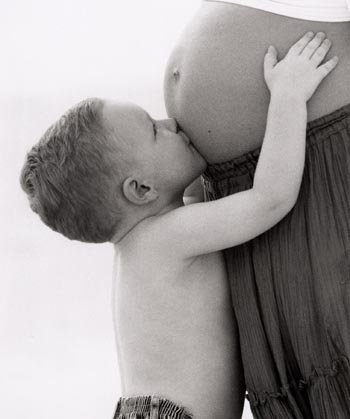 Pregnancy is a time of introspection, excitement, and, often, anxiety for most new mamas. When those new mamas also have other small children at home, that anxiety can become overwhelming as they worry about how they’ll cope with more than one child and how the current little loves of their life will cope with a new sibling. While these are very valid concerns, there are steps you can take to prepare your child for a new sibling and help them to adjust when the new baby arrives that will also help you to cope with life as a mama of more than one little blessing.
Pregnancy is a time of introspection, excitement, and, often, anxiety for most new mamas. When those new mamas also have other small children at home, that anxiety can become overwhelming as they worry about how they’ll cope with more than one child and how the current little loves of their life will cope with a new sibling. While these are very valid concerns, there are steps you can take to prepare your child for a new sibling and help them to adjust when the new baby arrives that will also help you to cope with life as a mama of more than one little blessing.
Once you discover you’re expecting, you’ve got months and months to prepare your child for the arrival of a new sibling, so here are 25 tips for during your pregnancy and after the new baby arrives to make the new baby transition a smoother and sweeter journey for everyone:
- Help your older child make their own ‘sister/brother on the way’ announcements so they feel like they are part of the transition from the beginning.
- Bring them along to sonograms, doctor’s appointments, shopping for baby things, etc.
- Reassure them that parents’ love multiplies instead of divides and that they will always be loved and important. Point out other families with more than one child so they can see that truth for themselves. If they’re old enough to understand, try a simple illustration such as letting them put different colors of water beads, one for each family member including the baby-on-the-war, into a glass of water. Tell them the water is like love, and it grows the beads into a rainbow of beautiful colors just like love grows our hearts bigger and bigger so there’s plenty of love for everyone.
- Present the new baby-on-the-way as ‘theirs,’ a special gift sent just for them so they will have a best friend for life. Talk about their friends who have siblings and how they always have someone to play with and someone to help them when they need it.
- Find children’s books about welcoming a new sibling, taking care of a new baby, when mommy breastfeeds, etc. to read to them before the birth. Here is a great list to get you started.
- Let them help decorate the nursery, put together the stroller, pack up the hospital bag (or prepare for your homebirth), buckle in the car seat, etc.
- Ask the person giving your baby shower to let your child ‘co-host’ and help with the party planning, set-up, serving snacks, and playing games.
- Help them make a special ‘welcome’ gift for the new baby and wrap it in paper they’ve decorated with stamps or finger paint.
- Buy them a special ‘welcome’ gift that you give them when they visit their new sibling for the first time. One idea is to buy them a child-sized baby carrier along with a doll, some diapers, wipes, mini baby blankets, etc. so they can take care of their baby while you take care of yours.
- Help them make their own family scrapbook with places to put the new baby’s pictures and pictures of them with their new little sibling when the new baby comes.
- Tell them stories about when they were born and show them pictures of their homecoming and first weeks of life.
- Let them help you work on updating their baby book.
- Take them to pick out a baby book for the new baby.
- Begin an open-ended conversation about how they’re feeling about having a new baby in the family to allow them to express their natural worries about how their role in the family might change, if they will still be able to play with their own toys, if the baby will cry a lot, etc. Continue this conversation throughout your pregnancy and after the new baby arrives to keep the communication lines open and your connection intact.
- Take them to visit the hospital and stop at the gift shop to buy a baby gift and a little treat for them to build excitement.
- Have lunch at the hospital cafeteria two or three times leading up to your birth to help them get used to the environment.
- Work on building other attached relationships with significant adults in your child’s life (spouse, grandparents, aunts, uncles, etc.) so that your little one is used to having their needs attended to by someone other than mama at times and so they can play and get one-on-one time with another caregiver while mama is busy with the new baby.
- On their first visit with their new sibling, let them sit in bed with you and hold their new little sibling. Have a ‘big sister/brother’ t-shirt for them to wear and take lots of pictures of both of them together and with other family members. Ask whoever you have caring for your older child to stop on the way home to print out a few of the pictures and then help them put the pictures in the scrapbook they created with you at home.
- When the new baby arrives continue to present the baby as ‘theirs’ to love and enjoy and care for. Include them in helping with diaper changes, snuggling on your other side with storybooks for you to read while nursing/feeding the new baby, singing the baby to sleep, etc. Make sure you invite them to participate instead of insisting because they may need some time to adjust to the newness of everything before they’re ready.
- Keep your expectations in line with your child’s developmental stage and make accommodations whenever possible. For instance, expecting a toddler to willingly give up their crib to a new baby is probably unrealistic. Moving your toddler to a new bed early in your pregnancy and then involving them in getting the crib ready for the new baby later on, after they’ve adjusted to their new bed, might be more successful.
- If your older child is a toddler or preschooler, you can expect some regression into babyish behavior as they work to adjust to their new role and find their place in the new family dynamic. Don’t respond with punishment, shaming, or pressure to ‘be a big boy or girl.’ Instead allow them the space and time they need to explore how it feels to be a baby again while at the same time drawing their attention to the benefits of being the older sibling (i.e. “Look how you can walk on your strong legs wherever you want to go! Your baby sister can’t walk yet, can she?” or “Wow, you can pick out your own shoes and even put them on yourself! Your baby brother can’t do that yet, can he?” or “Look at all the yummy foods you get to eat. It’s nice being bigger so you don’t have to just have milk, isn’t it?”)
- Be specific about how your child should treat the new baby. Instead of “Be nice!” try “Can you use a kind voice with your brother?” and instead of “Don’t be so rough!” try “Can you give your sister a gentle hug?”
- Make sure your child’s boundaries are clear and consistent. If you let them hop around the baby’s bouncer to make the new baby laugh one day, you can be sure they’ll try bouncing around the baby’s bouncer again and again and again. If you think that’s dangerous, set a clear boundary, explain the reason for the boundary, and give them an alternative (i.e. “Hopping next to the baby is dangerous. You might fall on the baby and hurt him! That would make you sad, and the baby would be sad, too. If you need to hop, you can hop like a bunny over here next to me.”)
- Keeping a consistent, familiar routine for your older child will help them to feel less out-of-control as they adjust to all of the other changes going on in their life. Make sure you’re flexible and in-tune with your child’s changing needs, though. They will most likely communicate their natural anxiety at this big transition in the family with some acting out behaviors, clinginess, whining, and/or resistance to bedtime and other normal routines. For instance, they may have been fine with one story and a hug at bedtime before the new baby arrived, but after their new sibling comes home they may need extra cuddles, time, and the reassurance of your love and ongoing commitment to their wellbeing before they’re able to go to sleep.
- Talk, talk, talk to your little ones throughout each and every day. Your hands may be busy more often than not, but you can still maintain that all-important connection through communication!
Keep in mind that nothing will completely eliminate the possibility of some jealousy, regression, or acting out when a new baby arrives because it’s a huge transition and it will take time for everyone in the family to adjustment, but these suggestions will go a long way toward setting the stage for the smoothest transition possible.
 Related posts:
Related posts:
Ten Steps to Surviving the First Three Months with a Newborn
The Gift of Breastfeeding
Love in the Time of Cosleeping
300+ Nicknames for Your Babykins…Doodlebug…Snugglebunny…
Babywearing Basics Resource Guide
Breastfeeding, Babywearing, and Bouncing Back into Shape after Baby
The Thoughtful Parent’s Guide to Positive Parenting Guides
12 Steps to Gentle Parenting
The Taming of the Tantrum: A Toddler’s Perspective
Practical, Gentle, Effective Discipline
10 Ways to Play with your Children when Play is the Last Thing on your Mind
200 Ways to Bless Your Children with a Happy Childhood
 Award-winnning author, L.R.Knost, is the founder and director of the children's rights advocacy and family consulting group, Little Hearts/Gentle Parenting Resources, and Editor-in-Chief of Holistic Parenting Magazine. Books by L.R.Knost include Whispers Through Time: Communication Through the Ages and Stages of Childhood ; Two Thousand Kisses a Day: Gentle Parenting Through the Ages and Stages ; The Gentle Parent: Positive, Practical, Effective Discipline ; and Jesus, the Gentle Parent: Gentle Christian Parenting the first four books in the Little Hearts Handbook gentle parenting series, and children’s picture books Petey’s Listening Ears and the soon-to-be-released Grumpykins series.
Award-winnning author, L.R.Knost, is the founder and director of the children's rights advocacy and family consulting group, Little Hearts/Gentle Parenting Resources, and Editor-in-Chief of Holistic Parenting Magazine. Books by L.R.Knost include Whispers Through Time: Communication Through the Ages and Stages of Childhood ; Two Thousand Kisses a Day: Gentle Parenting Through the Ages and Stages ; The Gentle Parent: Positive, Practical, Effective Discipline ; and Jesus, the Gentle Parent: Gentle Christian Parenting the first four books in the Little Hearts Handbook gentle parenting series, and children’s picture books Petey’s Listening Ears and the soon-to-be-released Grumpykins series.
August 26, 2013 | Categories: anxiety, attachment parenting, babywearing, birth, breastfeeding, children's books, communication, cosleeping, family, gentle parenting, motherhood, newborn, positive parenting, pregnancy, preschooler, toddler, Uncategorized | Tags: breastfeeding, new baby, newborns, nursing, parenting, pregnancy, preschoolers, siblings, toddlers | 5 Comments »
[Portions reprinted from The Gentle Parent: Positive, Practical, Effective Discipline by L.R.Knost. Two Thousand Kisses a Day: Gentle Parenting Through the Ages and Stages and Whispers Through Time: Communication Through the Ages and Stages of Childhood also available on Amazon and through other major retailers.]

We all have times when we struggle, when life gets hard, when stresses overtake us and the constant demands to grow and change and learn inherent in simply being human just feel like too much to bear.
Children are no different than adults in that they, too, can often feel overwhelmed by life. The sheer volume of growth and change and learning integral to childhood inevitably produce stress, though that isn’t necessarily a negative for all children. Some children, just like some adults, seem to have an innate ability to cope with stress, to adapt to change, and to face and conquer challenges. Some personalities even thrive on it!
But then there are those children who simply seem to struggle with life. Growth spurts cause incredible stress and discomfort. Change produces intense anxiety and resistance. And learning, being introduced to new thoughts and ideas, being stretched and challenged, inspires unease and distress.
These children are often labeled problem children, strong-willed, difficult, entitled, or brats. The reality, though, is that these are often the most sensitive children, small people who were created to be intimately in-tune with their bodies, their environment, and their fellow human beings. They feel, deeply and empathetically, other people’s pain and distress. They endure shifts in their surroundings like frontal assaults to their safety and security. They experience touch and movement of their bodies, and growth within their bodies, with painful intensity.
All too often, these sensationally gifted children are misunderstood. Their strong reactions to stimuli are misinterpreted as willfulness and stubbornness. They are punished instead of helped, controlled instead of supported, hurt instead of heard. Their uniqueness, gifts, and insights are forced underground where they often simmer in silence, bursting forth in flashes of rage or turning inward in brooding depression.
These children don’t need labels. They don’t need to be contained or controlled. They need what all children need…love, understanding, and guidance to grow into the gifted, unique individuals they were created to be.
Helping and supporting your sensitive child who is struggling is like building a bridge over troubled waters using the Three C’s of gentle discipline:
Connect:
- Observe and really get to know, understand, and appreciate the gifts and needs of the unique little person you are privileged to parent.
- Build a foundation of trust and respect in your parent/child relationship by ‘listening’ to the needs being expressed by your child’s behavior even when their behavior seems completely out of proportion to the situation.
Communicate:
- Keep an open door policy, particularly in the late evening hours when the house is quiet and everyone else is settled for the night. Sensitive children often need stillness to feel safe enough to begin processing all of the overwhelming stimuli and emotions they experience throughout the day.
- Help them to verbalize their feelings and experiences by listening to their hearts and not just their words, and quietly offering observations to help them to put things into perspective.
Cooperate:
- Work with your sensitive child to help them find coping mechanisms that will help them deal with overwhelming sensations, emotions, and situations. Some ideas are to offer them options such as…
- wearing noise-cancelling headphones to block out extraneous noises
- escaping to a Cozy Cave to take a break from the stresses of daily life
- creating a private code word that they can use to let you know they are feeling overwhelmed or that you can use to alert them that they may need to take a break or to dial things down a notch or two
- Equip them with tools to express themselves in acceptable ways (i.e. “It’s not okay to be rude, but it is okay to tell someone you need a break” or “It’s not okay to run away at school, but it is okay to go to your teacher and tell them you’re having a hard time.”)
- Work with them intentionally on a daily basis to overcome the stresses and minimize the impacts of what is, to us, normal daily life, but to them can be deeply troubling experiences.
Building a strong, supportive bridge into the future with your sensitive child will provide them with the coping skills they’ll need as adults to overcome normal stresses and challenges as well as those that come when life inevitably flows into troubled and turbulent waters.
For more tips for parenting your sensitive child and helping them learn coping mechanisms to deal with stresses, see The Gentle Parent: Positive, Practical, Effective Discipline.
Related posts:
Backtalk is Communication…LISTEN
The Gift of a Strong-Willed Child
The Problem with Punishment
When Children Act Out ~ Reflecting Our Emotions
Why Whining is a Win!
Rethinking Tattling
The Incredible Power of the Whisper
The Taming of the Tantrum: A Toddler’s Perspective
12 Steps to Gentle Parenting
The Thoughtful Parent’s Guide to Positive Parenting Guides
Simon and Garfunkel – Bridge Over Troubled Water Studio Version
When you’re weary, feeling small
When tears are in your eyes
I will dry them all
I’m on your side
When times get rough
And friends just can’t be found
Like a bridge over troubled water
I will lay me down
Like a bridge over troubled water
I will lay me down
When you’re down and out
When you’re on the street
When evening falls so hard,
I will comfort you
I’ll take your part
When darkness comes
And pain is all around
Like a bridge over troubled water
I will lay me down
Like a bridge over troubled water
I will lay me down
Oh, if you need a friend
I’m sailing right behind
Like a bridge over troubled water
I will ease your mind
Like a bridge over troubled water
I will ease your mind…
 Award-winnning author, L.R.Knost, is the founder and director of the children's rights advocacy and family consulting group, Little Hearts/Gentle Parenting Resources, and Editor-in-Chief of Holistic Parenting Magazine. Books by L.R.Knost include Whispers Through Time: Communication Through the Ages and Stages of Childhood ; Two Thousand Kisses a Day: Gentle Parenting Through the Ages and Stages ; The Gentle Parent: Positive, Practical, Effective Discipline ; and Jesus, the Gentle Parent: Gentle Christian Parenting the first four books in the Little Hearts Handbook gentle parenting series, and children’s picture books Petey’s Listening Ears and the soon-to-be-released Grumpykins series.
Award-winnning author, L.R.Knost, is the founder and director of the children's rights advocacy and family consulting group, Little Hearts/Gentle Parenting Resources, and Editor-in-Chief of Holistic Parenting Magazine. Books by L.R.Knost include Whispers Through Time: Communication Through the Ages and Stages of Childhood ; Two Thousand Kisses a Day: Gentle Parenting Through the Ages and Stages ; The Gentle Parent: Positive, Practical, Effective Discipline ; and Jesus, the Gentle Parent: Gentle Christian Parenting the first four books in the Little Hearts Handbook gentle parenting series, and children’s picture books Petey’s Listening Ears and the soon-to-be-released Grumpykins series.
August 24, 2013 | Categories: aggression, anxiety, childhood, children, communication, defiance, discipline, fear, gentle discipline, gentle parenting, lashing out, middle childhood, motherhood, preschooler, rebellion, stress, tantrum, teens, toddler, Uncategorized | Tags: communication, discipline, parenting | 9 Comments »
[Portions reprinted from Whispers Through Time: Communication Through the Ages and Stages of Childhood by L.R.Knost. Two Thousand Kisses a Day: Gentle Parenting Through the Ages and Stages and The Gentle Parent: Positive, Practical, Effective Discipline also available through Amazon and other major retailers.]
~~~~~~~~~~~~~~~~~~~~~
 “She won’t share!”
“She won’t share!”
“He took my crayon!”
“They won’t let me play with them!”
“He looked at me!”
“She poked me!”
“They’re jumping on the couch!”
“He won’t be my friend!”
Few things irritate adults as quickly as a tattle-tale. The kneejerk response is often “Stop tattling!” or “Handle it yourself!” or even to shame or punish little tattlers.
But stop for a moment and think: What is being communicated? What is a child actually trying to tell us when they tattle? What message is a child getting by our response?
Tattling is, in effect, a child seeking wise counsel for a situation they don’t know how to handle. When faced with a conflict that just weeks or months earlier would have resulted in tears or snatching or hitting or some combination of all three, a child who has matured and begun to develop some self-control is learning to stop and think instead of just react. But what do they do if no solution presents itself? What if they’ve tried to reason or negotiate with the object of their conflict and been unable to come to a resolution?
What do adults do when they don’t know what to do? Typically, they either respond with maturity and seek out someone they respect and trust to help them deal with the situation, or they degenerate into chaotic emotions and resort to anger, power-plays, and manipulation. Often their response is influenced by their own childhood and how they were taught or not taught, as the case may be, to handle conflict.
When a child tattles, what they are actually doing is a rudimentary form of the advanced life skill of ‘Pause. Think. Respond.’ but they need help finding an appropriate and effective response. The child who seeks out an adult for guidance is indicating trust in the adult and respect for the adult’s opinions and abilities. If the adult reacts with irritation, “Stop tattling!” or rejection, “Handle it yourself!” or punishment, the child learns not to trust, not to seek guidance, and not to share struggles and problems with those entrusted with their care, a potentially dangerous mentality, as we’ll discuss later. In addition, an excellent teachable moment is lost.
When a child approaches a trusted adult with a problem, the child is saying, “This is important. Hear me. Help me.” This is a wonderful opportunity to guide the child through the process of conflict resolution. So often we relegate life skills such as conflict resolution to textbooks and worksheets, if we address them at all. But learning is far more powerful and effective if it is tied to real-life, real-time issues that are important to us, that impact our lives, that matter.
So how do we handle the kneejerk irritation response when confronted with a tattling child? First, tossing out the tattling label entirely helps to adjust our mindset and focus on the child’s need for guidance. We can rename it ‘sharing’ or whatever else will help us in the rethinking process (though in our home it is just a normal and accepted part of our parent/child interaction and doesn’t have a name of its own to distinguish it from any other kind of communication).
Next, we can have prepared responses ready so that we aren’t ‘stuck’ when we’re trying to cope with our instinctive irritation in the same moment that we need to focus on helping an upset child in need of guidance.
Here are some possible responses:
If the child is over-wrought…
- “I can see you’re upset. Let’s take a minute and breathe together, and then we’ll be able to think clearly.”
When the child is calm enough to talk…
- “Can you tell me what happened to upset you?”
- “Why do you think they did that?”
- “How do you think we should handle that?”
- “What could you have done differently?”
- “What would you want them to do if you had been the one to do that?”
Often just feeling heard is enough to help the child find their own solution to the problem, but if further guidance is needed we can brainstorm solutions with them, walk them through some possible scenarios, or step in and help them to resolve the problem.
In addition to teaching valuable conflict resolution skills, giving our children the sure knowledge that they aren’t alone in the world and don’t have to cope with life on their own is a vital message. Logically speaking, does it really make sense to teach our children that they can’t trust us with their problems, can’t come to us when they’re stressed and don’t know how to cope, can’t seek wise counsel when confronted with situations that are beyond their ability to handle?
The potential ramifications of that mindset are chilling. Can we really expect children to have the mental clarity and emotional maturity to be able to distinguish ‘good’ telling from ‘bad’ telling when faced with bullying or peer pressure or sexual predators? It’s well known that sexual predators manipulate children with threats such as, “No one will believe you,” and, “No one will listen, anyway.”
Guarding our children against those lies, against the bullies, against pressure from their peers is essential, and keeping the communication doors flung wide open is certainly a powerful step in the right direction.
Related posts:
The Thoughtful Parent’s Guide to Positive Parenting Guides
The Gift of a Strong-Willed Child
When Children Hit~10 Tips for Parents
The Problem with Punishment
Backtalk is Communication…LISTEN
12 Steps to Gentle Parenting
Practical, Gentle, Effective Discipline
Why Whining is a Win!
The Color of Change
 Award-winnning author, L.R.Knost, is the founder and director of the children's rights advocacy and family consulting group, Little Hearts/Gentle Parenting Resources, and Editor-in-Chief of Holistic Parenting Magazine. Books by L.R.Knost include Whispers Through Time: Communication Through the Ages and Stages of Childhood ; Two Thousand Kisses a Day: Gentle Parenting Through the Ages and Stages ; The Gentle Parent: Positive, Practical, Effective Discipline ; and Jesus, the Gentle Parent: Gentle Christian Parenting the first four books in the Little Hearts Handbook gentle parenting series, and children’s picture books Petey’s Listening Ears and the soon-to-be-released Grumpykins series.
Award-winnning author, L.R.Knost, is the founder and director of the children's rights advocacy and family consulting group, Little Hearts/Gentle Parenting Resources, and Editor-in-Chief of Holistic Parenting Magazine. Books by L.R.Knost include Whispers Through Time: Communication Through the Ages and Stages of Childhood ; Two Thousand Kisses a Day: Gentle Parenting Through the Ages and Stages ; The Gentle Parent: Positive, Practical, Effective Discipline ; and Jesus, the Gentle Parent: Gentle Christian Parenting the first four books in the Little Hearts Handbook gentle parenting series, and children’s picture books Petey’s Listening Ears and the soon-to-be-released Grumpykins series.
August 12, 2013 | Categories: anxiety, bullying, childhood, children, communication, learning, middle childhood, preschooler, Uncategorized | Tags: bullying, communication, discipline, parenting, tattling | 10 Comments »
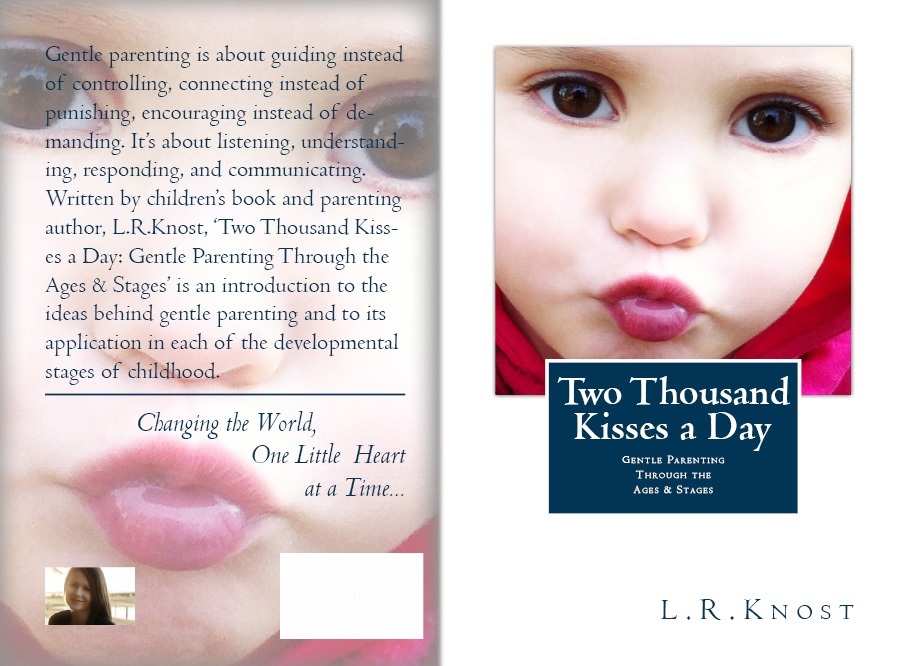 Two Thousand Kisses a Day: Gentle Parenting Through the Ages and Stages now available on Amazon:
Two Thousand Kisses a Day: Gentle Parenting Through the Ages and Stages now available on Amazon:
~The birth story of a book~
A mother is born…
Many years ago (26 to be exact!), a small, scared, pregnant, teenage girl walked down the aisle to her tall, scared, clueless, young man and they said their “I do’s.”
But what were they going to do? No earthly idea! They didn’t have the internet to surf for blogs about parenting and marriage, couldn’t afford the few paltry magazines available on those subjects at the time, and weren’t convinced that the way their parents had raised them was exactly how they wanted to raise their unexpected little blessing. So, they simply joined hands and hearts and figured it out the old-fashioned way…through trial and error.
The young girl gave birth prematurely and, after a terrifying NICU stay, brought home her barely 5 lb baby boy. Since the young couple were living on one income and were barely able to feed themselves, it made sense to them to breastfeed their little one. Neither one had ever even seen a mother breastfeeding her baby or even heard of a lactation consultant and no one at the hospital had mentioned breastfeeding at all, so the two young people just kept working through the cracked, bleeding nipples, engorgement, over-supply, and other issues until they got it figured out…and then they were breastfeeders!
Neither one of the young couple had ever read a parenting book or had ever even heard the words ‘cry-it-out,’ and the young girl discovered their first night home how much easier it was to clear away all of the pillows and blankets to keep her baby safe and then simply take her little guy into bed with her and breastfeed him when he was hungry…and then they were co-sleepers!
‘Self-soothing’ was another term the two young people had never heard, so the two of them just did what came naturally and picked up their baby when he fussed or grunted or just looked cute and finally found it easier to just snuggle their little preemie into a baby carrier and tote him around with them wherever they went…and then they were babywearers!
As their precious little guy got bigger and began to explore his new world, the young couple delighted in everything he did and simply moved him or distracted him with songs and toys if he got into things. They couldn’t bear the thought of hurting their son, so punitive parenting just wasn’t an option. They decided to treat their little guy like a person instead of a possession and communicate with him instead of punishing him…and then they were gentle discipliners!
Now, this journey might sound like an easy one when summed up this way, but I can assure you it wasn’t. The young couple, my amazing husband and I, encountered strong criticism of our parenting choices through the years:
- We were warned that our marriage would suffer at the very least, and our babies would suffocate at the worst, if we slept with them in our bed instead of putting them in isolation to sleep.
- We were informed that my breasts would look like deflated balloons and reach my knees by my thirties if I breastfed more than a few weeks.
- We were admonished that our children would grow into spoiled brats if we responded to their needs instead of teaching them to ‘deal with it’ and ‘self-soothe’ their own, and would end up as social outcasts or criminals if we encouraged and guided them instead of spanking them.
These challenges to our parenting style were difficult at the time, and they sometimes even resulted in people choosing to de-friend us (not Facebook de-friending, in real life!), but that had the powerful positive effect of making us really examine what our beliefs were and, as a result, strengthening and solidifying our values, our marriage, and our family.
As for the dire warnings listed above:
- Our beautiful, strong, loving marriage is in its 27th year.
- Our children all survived and thrived on co-sleeping (our littlest is still safely and contentedly sleeping in our bed) and have, in their own time, moved happily to their own rooms.
- Except for being a couple of cup sizes larger at the moment since I’m breastfeeding a toddler, lol, my breasts are normal despite the fact that I’ve breastfed little ones for a cumulative 10+ years of my adult life!
- Our children are, in order, a 25-year-old Pastor (our firstborn son mentioned in the story above who is now a husband and father of two!), a 23-year-old Family Therapist, an 18-year-old pre-med university student on scholarship, 13- and 7-year-old beautiful and well-behaved homeschooled girls with lots of friends (soooo not social outcasts!), and a sweet and happy 2-year-old baby girl. Not a spoiled brat or criminal in the bunch!
Our journey to gentle parenting has had another, somewhat unexpected, effect. While we may not agree with others’ parenting choices, we have been on the receiving end of criticism far too long not to have learned this lesson: Gentle parenting is for parents, too! We have learned to respond gently to our friends who don’t agree with us, even when they don’t respond gently to us. Responding with harshness and criticism doesn’t work with adults any better than it does with children! Responding gently to those who disagree with us may or may not affect their parenting choices, but what it does do is model respectful behavior and conflict resolution to our children and, most of the time, preserve dear friendships.
A gentle parenting advocate is born…
This journey also resulted in a passion for children and family harmony that launched me many years ago into the world of parent coaching and child advocacy and later initiated the creation of Little Hearts/Gentle Parenting Resources as a consulting and educational resource for parents, caregivers, and educators. The culmination of this work led to the development of a series of gentle parenting handbooks designed to equip parents with the information and tools they need to gently guide their children from infancy through toddlerhood and the preschool years and on through middle childhood, the teen years, and beyond.
A book is born…
Two Thousand Kisses a Day: Gentle Parenting Through the Ages and Stages is the first in the series. It is an introduction to the ideas behind gentle parenting and provides practical examples of its application in each of the developmental stages of childhood such as the transition from diapers to potty, problems with sharing, coping with picky eaters, guiding children gently through behavioral issues, and more!
*also published in The Natural Parent Magazine
 Award-winnning author, L.R.Knost, is the founder and director of the children's rights advocacy and family consulting group, Little Hearts/Gentle Parenting Resources, and Editor-in-Chief of Holistic Parenting Magazine. Books by L.R.Knost include Whispers Through Time: Communication Through the Ages and Stages of Childhood ; Two Thousand Kisses a Day: Gentle Parenting Through the Ages and Stages ; The Gentle Parent: Positive, Practical, Effective Discipline ; and Jesus, the Gentle Parent: Gentle Christian Parenting the first four books in the Little Hearts Handbook gentle parenting series, and children’s picture books Petey’s Listening Ears and the soon-to-be-released Grumpykins series.
Award-winnning author, L.R.Knost, is the founder and director of the children's rights advocacy and family consulting group, Little Hearts/Gentle Parenting Resources, and Editor-in-Chief of Holistic Parenting Magazine. Books by L.R.Knost include Whispers Through Time: Communication Through the Ages and Stages of Childhood ; Two Thousand Kisses a Day: Gentle Parenting Through the Ages and Stages ; The Gentle Parent: Positive, Practical, Effective Discipline ; and Jesus, the Gentle Parent: Gentle Christian Parenting the first four books in the Little Hearts Handbook gentle parenting series, and children’s picture books Petey’s Listening Ears and the soon-to-be-released Grumpykins series.
February 20, 2013 | Categories: adolescence, anxiety, attachment parenting, baby led weaning, babywearing, birth, books, breastfeeding, character, childhood, children, communication, cosleeping, discipline, family, fear, gentle discipline, gentle parenting, meltdown, middle childhood, motherhood, natural parenting, newborn, nursing, parenting guide, positive discipline, positive parenting, preschooler, rebellion, sharing, soothing, spanking, tantrum, teens, time-in, time-out, toddler, volunteering, wisdom | Tags: gentle discipline, gentle parenting, parenting book, parenting guide, positive parenting | 3 Comments »
[By L.R.Knost, best-selling author of The Gentle Parent: Positive, Practical, Effective Discipline; Whispers Through Time: Communication Through the Ages and Stages of Childhood; Two Thousand Kisses a Day: Gentle Parenting Through the Ages and Stages; and Jesus, the Gentle Parent: Gentle Christian Parenting available on Amazon and through other major retailers.]
*********************
 What do you get when you cross a curious toddler with a Christmas tree covered with glittering, dangling ‘toys’ and enticing, shiny lights? At the very least, a season of toddler chasing and redirecting, and at the worst a season of shattered-glass hazards and tree-scaling, toppling nightmares. So what’s a parent to do? Must we scrap the tree so we can have a merry Christmas while we have little ones in the house? Not at all!
What do you get when you cross a curious toddler with a Christmas tree covered with glittering, dangling ‘toys’ and enticing, shiny lights? At the very least, a season of toddler chasing and redirecting, and at the worst a season of shattered-glass hazards and tree-scaling, toppling nightmares. So what’s a parent to do? Must we scrap the tree so we can have a merry Christmas while we have little ones in the house? Not at all!
Here is an Advent list with a twist…24 Christmas safety tips for parents with tiny people who love to explore:
 1.) A Christmas tree plopped down right in the middle of a child’s playspace (i.e. family room, living room, den) is just too much temptation for any little person, so one solution is to place the tree in a lesser-used room such as a study or office or even a covered porch where the tree can be seen but is less accessible to little explorers.
1.) A Christmas tree plopped down right in the middle of a child’s playspace (i.e. family room, living room, den) is just too much temptation for any little person, so one solution is to place the tree in a lesser-used room such as a study or office or even a covered porch where the tree can be seen but is less accessible to little explorers.
2.) Another option is to place the Christmas tree in a play yard like the one pictured to keep the tree safe while still having it in a central location in the house for everyone to enjoy.
3.) A tabletop tree is also an option. Keep the tree away from the edges and watch out for dangling tree skirts and light cords so little hands can’t pull the tree down on top of little heads.
4.) For families like ours who have lots of little ones toddling around year after year, a child-proof tree may be the answer. We used fishline to anchor our tree to the ceiling after one tiny climber toppled the tree over on herself a few times. Non-breakable ornaments (homemade ornaments are great  alternatives) tied to the tree with ribbons instead of metal hooks (choking hazard!) are the solution to our current little spelunker who loves to crawl under the Christmas tree and lay looking up at the sparkling lights from her little hidey-hole.
alternatives) tied to the tree with ribbons instead of metal hooks (choking hazard!) are the solution to our current little spelunker who loves to crawl under the Christmas tree and lay looking up at the sparkling lights from her little hidey-hole.
5.) Be sure to check that your artificial tree is fire-rated or your real tree is fresh (i.e. easily bendable branches, no dropping needles) and keep your real tree well-watered to reduce fire danger.
6.) Always check lights for broken, loose, or missing bulbs, and make sure wires aren’t frayed and sockets aren’t cracked. Turn lights off when leaving your home or going to bed.
7.) For outdoor lighting/decorating, be sure to use extension cords rated for outdoor use, and don’t overload the outlet by stringing together more lights than the instructions allow. Elevate cords to avoid them sitting in water or on dry leaves. Have lights on a timer or turn lights out when leaving your home or going to bed.
8.) When decorating, place figurines and keepsakes out of reach of little hands to avoid constantly chasing giggling toddlers who find your reaction to their snatch-and-run game a great source of holiday entertainment.
9.) Avoid decorating with real holly or mistletoe in areas accessible to small children, as both are toxic if eaten.
10.) Never decorate your tree with candles, and keep candles separated from pine branches on tabletops and mantles by placing them in deep glass votives. Never leave a small child alone in a room with a burning candle.
11.) Keep snow sprays out of reach as they can be toxic if inhaled and can cause injury if sprayed into eyes.
12.) When entertaining, keep hot plates away from the edges of tables and remind guests not to leave hot or alcoholic beverages within reach of small children.
13.) House guests may not be used to having small children around, so be extra vigilant about medicine bottles, unattended purses, open luggage, and other dangers that may visit along with your guests.
14.) When purchasing gifts, check labels for age recommendations. Keep in mind that even if you think a little one is advanced enough to enjoy a toy that is recommended for an older child, the toy may contain choking hazards or other dangers to a small child.
 15.) Unless you like wrapping presents over and over and…well, you get the picture, avoid setting wrapped packages out under the tree if the tree is accessible to small children. Keeping your expectations in line with your child’s developmental stage is a key element to avoiding conflict in your parent/child relationship and making your holidays less stressful and more enjoyable!
15.) Unless you like wrapping presents over and over and…well, you get the picture, avoid setting wrapped packages out under the tree if the tree is accessible to small children. Keeping your expectations in line with your child’s developmental stage is a key element to avoiding conflict in your parent/child relationship and making your holidays less stressful and more enjoyable!
16.) In the flurry of gift opening on Christmas morning, small objects from ripped open packages (like the 42 little plastic tabs to hold a $5 rattle in a cardboard box!) can end up scattered amongst the toys and boxes and paper, creating a sea of choking hazards. Keep a big box handy to throw packaging and wrapping paper into, and choose one or two toys to remove from their packaging for immediate play while putting the other opened presents away in another box to be opened later.
17.) Never let children throw wrapping paper into the fireplace, as this can cause a dangerous flash fire.
18.) Keep a close watch on your little one’s diet throughout the holidays. In the busyness of the season, nutrition often takes a backseat to convenience, and an overload of junk foods and sweets can cause tummy aches and crankiness which won’t help them or you to have a jolly holiday.
19.) Another nutritional danger of the season is unintentional weaning. If you’re nursing a little one, the constant changes in schedule, the busyness, the stress, and the baby being passed from one relative to another can result in missed feedings and reduced milk supply. Making a conscious effort to take regular nursing breaks in a quiet room with your little nursling will give both of you a chance to reconnect and de-stress a bit and keep your nursing relationship intact.
20.) Also, be very aware of your little one’s sleep patterns during the holiday season. All of the disturbances mentioned in #19 can wreak havoc on a small child’s sleep schedule and, along with the almost inevitable over-stimulation of the music, lights, and visitors, that can make the holidays a miserable time for a little person.
21.) Fireplaces should be regularly inspected to prevent chimney fires, and protective fire-screens and/or baby gates should be used to keep little ones safe.
22.) Space heaters are a well-known fire hazard. Make sure you are using them according to the manufacturer’s specifications and that they are in good working order. Never leave a small child unattended in a room with a space heater.
23.) Keep in mind that, while you know and love those visiting relatives your little one has never met, expecting a small child to instantly let a person who is a total stranger to them hold and kiss and play with them is unrealistic. If we want our children to exercise restraint and caution with random strangers at the  park/mall/etc., we need to allow them to set limits they are comfortable with when it comes to physical contact and interaction with the ‘strangers’ in our homes, as well.
park/mall/etc., we need to allow them to set limits they are comfortable with when it comes to physical contact and interaction with the ‘strangers’ in our homes, as well.
24.) And, last but certainly not least, while pictures of their little ones with Santa may be every parent’s heart’s desire, small children often don’t share that desire. Instead of forcing your child to sit in a strange man’s lap (not exactly a precedent we want to set for our children!), if your child isn’t comfortable with the idea, get creative and try getting pictures of your toddler standing near Santa while he plays peek-a-boo with them or try kneeling on one knee next to Santa, yourself, with your little one on your other knee. You never know, those pictures may end up being your all-time favorites!
~~~~~~~~~~~~~~
More ideas about how to make the holiday season fun-filled and meaningful, as well as keeping the joy and wonder of childhood alive for your little ones year round:
The Spirit of Christmas… The Great Santa Claus Debate
Making gratitude and generosity a standard of life… 7 Tips and Traditions to Make Giving a Standard of Living
The Reason for the Season… Celebrating Jesus with a Santa Claus Christmas
A happy childhood sends a child into adulthood with a baggage of confidence and kindness instead of disillusionment and anger. 200 Ways to Bless Your Children with a Happy Childhood
The human brain needs time to process, categorize, prioritize, analyze, and otherwise make sense of all of the trillions of bits of information that it receives each day. Non-structured playtime for children functions much like sleep does for adults, giving their brains the time and space they need to move short-term memory to long-term learning. 25 Reasons NOT to Keep Children Busy
In the world of a child wonders are as simple as sticks and sheets, leaves and books, boxes and giggles, and the promise in a rainy day. The Seven Wonders of the World of Childhood
Children who love to read…READ! Engaging children’s hearts in the wonder of reading instead of just training their minds in its mechanics. Raising Bookworms
From hitting to defiance to tantrums to testing the boundaries and more, here are gentle parenting tools, tips, and techniques. Practical, Gentle, Effective Discipline
 Award-winnning author, L.R.Knost, is the founder and director of the children's rights advocacy and family consulting group, Little Hearts/Gentle Parenting Resources, and Editor-in-Chief of Holistic Parenting Magazine. Books by L.R.Knost include Whispers Through Time: Communication Through the Ages and Stages of Childhood ; Two Thousand Kisses a Day: Gentle Parenting Through the Ages and Stages ; The Gentle Parent: Positive, Practical, Effective Discipline ; and Jesus, the Gentle Parent: Gentle Christian Parenting the first four books in the Little Hearts Handbook gentle parenting series, and children’s picture books Petey’s Listening Ears and the soon-to-be-released Grumpykins series.
Award-winnning author, L.R.Knost, is the founder and director of the children's rights advocacy and family consulting group, Little Hearts/Gentle Parenting Resources, and Editor-in-Chief of Holistic Parenting Magazine. Books by L.R.Knost include Whispers Through Time: Communication Through the Ages and Stages of Childhood ; Two Thousand Kisses a Day: Gentle Parenting Through the Ages and Stages ; The Gentle Parent: Positive, Practical, Effective Discipline ; and Jesus, the Gentle Parent: Gentle Christian Parenting the first four books in the Little Hearts Handbook gentle parenting series, and children’s picture books Petey’s Listening Ears and the soon-to-be-released Grumpykins series.
November 28, 2012 | Categories: Advent, anxiety, breastfeeding, Christmas, toddler, traditions, Uncategorized | Tags: Advent, Christmas, toddler | 5 Comments »
[From Raising Bookworms: Life, Learning, and Literacy by L.R.Knost available 2014; Two Thousand Kisses a Day: Gentle Parenting Through the Ages and Stages, Whispers Through Time: Communication Through the Ages and Stages of Childhood, and The Gentle Parent: Positive, Practical, Effective Discipline now available on Amazon and through other major retailers.]
 Homeschooling a unique learner can be challenging simply because they don’t get the benefit of access to testing and professional support without a lot of initiative, research, phone calls, and door-knocking on your part. But the trade-off is the freedom to tailor your teaching and learning environment to your child’s needs, and that is of incredible value when educating a unique learner.
Homeschooling a unique learner can be challenging simply because they don’t get the benefit of access to testing and professional support without a lot of initiative, research, phone calls, and door-knocking on your part. But the trade-off is the freedom to tailor your teaching and learning environment to your child’s needs, and that is of incredible value when educating a unique learner.
Albert Einstein said, “Everybody is a genius. But if you judge a fish on its ability to climb a tree, it will live its whole life believing that it is stupid.” Unique learners have beautiful minds just waiting to find their genius. We just need to look outside of the box to help them find it!
Here are some of the tips, tools, and techniques I’ve learned through years of homeschooling my unique learners to help them work through the challenges they face on a daily basis:
1.) Lighten up…Everything in life is easier if you take it with a grain of salt and learn to laugh. Our unique learners will have more struggles and challenges than the average person throughout life, not just during their school years. That is an unavoidable fact. But who wants to be ‘average’ anyway? Help them to celebrate their uniqueness and embrace the future with grace and humor by sharing your own struggles, modeling coping techniques, and being able to laugh at your own mistakes. Make ‘even missteps are valuable steps on the road to success’ your homeschool motto!
2.) Play…Children learn best through play, and that applies to therapy, as well. Experience is the only true path to learning, so let their imaginations soar as they do the hard work of learning to cope with their unique challenges. (See some play-based, brain-enriching, and eye-tracking activities below)
3.) Jazz it up…Music truly is medicine for the soul. Buy a good set of headphones (not earbuds) and play classic instrumentals softly while your unique learner is trying to concentrate, whether it be on reading or writing or drawing, etc. Filtering out the cacophony of life and soothing their stress levels with the gentle strains of Mozart are only some of the benefits of music. Another benefit is that the rhythms, cadence, and timing of music actually have an organizing effect on the brain!
4.) Exercise…Invest in an exercise bicycle (We got ours for $15 from a yard sale!) that lets your unique learner sit in a comfortable seat while pedaling. The cross-over action of pedaling also has an organizing effect on the brain, and, if used while reading or playing video games (Video games can be great exercises for eye-tracking if you choose the right ones!) can actually increase the speed and effectiveness of learning.
unique learner sit in a comfortable seat while pedaling. The cross-over action of pedaling also has an organizing effect on the brain, and, if used while reading or playing video games (Video games can be great exercises for eye-tracking if you choose the right ones!) can actually increase the speed and effectiveness of learning.
5.) Get crunchy…Believe it or not, another ‘brain organizing’ activity is chewing, particularly crunchy foods, while reading, etc. Some good choices are pretzels, carrot sticks, celery, granola, and nuts. (If you’ve got a sensory sweetie like I do, be careful to let them choose something that won’t send their senses into overdrive.) Sugarless chewing gum can be substituted when you go places where foods aren’t appropriate, but still would like to offer your child a calming, organizing aid.
6.) Listen, listen, listen…Your unique learner will have more than their share of stress and possibly a harder time articulating it than others might. Slow down and really focus on what they are communicating. Listen ‘between the lines’ to their heart, their hurts, their fears, their needs. Be their safe place, their source of comfort and renewal.
7.) Hug it out…Physical closeness is healing, and so make sure that along with the extra struggles and challenges your unique learner faces, they get lots of extra cuddles, snuggles, and hugs. When they get older, a gentle touch on their shoulder or a light hand on their arm will be instantly calming and comforting because it will tap into those feelings of comfort and closeness from earlier childhood.
8.) Watch and learn…Just as every child is different, every child with challenges is unique in how they manifest those challenges and how they handle them. Paying careful attention to your own unique learner’s personality, struggles, aversions, triggers, etc. will give you clues as to how to help them learn to cope. With SPD (Sensory Processing Disorder), for example, avoiding unpleasant stimulus and providing needed stimulus is the name of the game. Typically, you’ll want to provide a quiet learning area at home, lots of freedom to move, permission to step away and de-stress when they feel overwhelmed, etc. and, when going out, avoid buffet-style restaurants and loud, crowded shopping and entertainment venues.
9.) Guide them gently…Discipline (guiding, modeling, teaching, etc.) invites communication and strengthens your parent/child connection. Punishment stifles communication and strains parent/child connections. Keep those vital lines of communication open and your parent/child connection healthy by providing consistent boundaries and gentle guidance, being open to discussion, and modeling the desired behavior.
10.) Read, read, read…Successful readers are not simply those who understand the mechanics of reading any more than successful biking is understanding the mechanics of a bicycle. Readers are born when a love for reading is fostered. Let them see you reading often. Cuddle up and read to them when they are young. Co-read (you read a sentence, they read a sentence, etc) when they are new readers or when they are tired or struggling. Let them read comics (The relation of pictures to words is a huge aid in reading comprehension.). For more reading tips, see Raising Bookworms.
Here are some exercises and activities that have helped my Renaissance Girl with her challenges with SPD, dyslexia, ADD, visual/auditory processing disorders, dyscalculia, etc:
Gross motor and fine motor cross-over exercises to get the two sides of the brain communicating more efficiently…
~Bouncing a brightly colored ball back and forth between us using alternate hands (left, right, left, right, etc.)
~Skipping, marching, swinging while singing 
~Climbing
~Balance beam
~Bicycling
~Piano
~Sorting 
Brain-organizing activities…
~Memory matching
~Tonal music
~Free-style building with blocks, tinkertoys, legos, etc.
~Design-matching building
~Sensory bins
Eye-tracking activities…
~Laser pointer games-following a laser pointer light in a darkened room, pointing to moving targets (i.e. bubbles), etc.
~Ceiling tracing-following the seam of the wall and ceiling from corner to corner moving only the eyes
~Video games-Flash Focus and Brain Age are good choices for the Gameboy. Wii Fit, Carnival Games, and Sports Games are good for the Wii. There are also great games for improving eye-tracking for the X-box, Playstation, and online. If you do the research to find what best fits your child’s interests, you’ll have much better participation!
Visual-motor learning…
~Clay letters-tactile learning by forming letters and words on a template with clay or dough 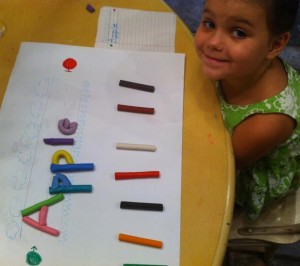
~Contextual learning-Children with dyslexia tend to learn better in context than by breaking things down to their parts, so phonics-based learning is often mind-boggling for them. Flashcards are a no-go because speed and movement impede their attempts to focus rather than help them. Writing-based learning such as copying and illustrating short poems, copying a short sentence from a wall-mounted chalkboard or large paper taped to the wall and illustrating it, writing and illustrating their own stories, and writing stories on the computer are great ways to help them learn to read.
~Once they are beginning to read, graphic novels, large-print chapter books on topics that interest them, and continued creative writing are excellent practice.
~Online reading games can be helpful, but only if they are untimed (Timed anything is a huge stressor and sets them up for frustration and failure.) and your child feels comfortable with the level of activity and brightness on the screen as otherwise these can cause headaches and their eyes to tire quickly.
These tips are not, of course, exhaustive or a replacement for professional therapies. But as you work your way through what can often be a labyrinth of paperwork, meetings, appointments, etc. on your way to finding the services your child needs, these may help to ease the wait a bit. 🙂
Related posts:
Children who love to read…READ! Engaging children’s hearts in the wonder of reading instead of just training their minds in its mechanics. Raising Bookworms
It’s time for a return to childhood, to simplicity, to running and climbing and laughing in the sunshine, to experiencing happiness instead of being trained for a lifetime of pursuing happiness…it’s time to let children be children again. A Return to Childhood
Think homeschooled children are unsocialized, over-controlled, locked-away-from-the-world misfits? Think again! My Renaissance Girl
Successful reading means far more than possessing the ability to read. Engaging the hearts of students moves reading success beyond a life skill and turns it into a life style. And graphic novels are too powerful of a tool in our arsenal to be disregarded because of pride or prejudice. Raising Super Readers~The MARVELous Power of Comic Books!
In the world of a child wonders are as simple as sticks and sheets, leaves and books, boxes and giggles, and the promise in a rainy day. The Seven Wonders of the World of Childhood
Parenting choices strongly impact the level and type of attachment a child develops and, by extension, the development of a love of learning. A love of learning grows when it isn’t stifled by fear or stress or regimented by over-structuring or a focus on achievement or competition. Parents fostering a healthy attachment are thus also fostering a life-long love of learning in their children. Live to Play~Play to Learn~Learn to Live!
If you give a toddler a book
He’ll climb into your lap
While he’s in your lap
He might lay his head on your chest
When he lays his head on your chest
He’ll hear your heartbeat
When he hears your heartbeat
He’ll probably ask if you can hear… If You Give A Toddler A Book…
Einstein recognized his unique lens and often commented about it and about how organized education systems didn’t accommodate individuality and creativity. Here is a look into this ‘unique learner’s’ mind in his own words…Beautiful Minds
 Award-winnning author, L.R.Knost, is the founder and director of the children's rights advocacy and family consulting group, Little Hearts/Gentle Parenting Resources, and Editor-in-Chief of Holistic Parenting Magazine. Books by L.R.Knost include Whispers Through Time: Communication Through the Ages and Stages of Childhood ; Two Thousand Kisses a Day: Gentle Parenting Through the Ages and Stages ; The Gentle Parent: Positive, Practical, Effective Discipline ; and Jesus, the Gentle Parent: Gentle Christian Parenting the first four books in the Little Hearts Handbook gentle parenting series, and children’s picture books Petey’s Listening Ears and the soon-to-be-released Grumpykins series.
Award-winnning author, L.R.Knost, is the founder and director of the children's rights advocacy and family consulting group, Little Hearts/Gentle Parenting Resources, and Editor-in-Chief of Holistic Parenting Magazine. Books by L.R.Knost include Whispers Through Time: Communication Through the Ages and Stages of Childhood ; Two Thousand Kisses a Day: Gentle Parenting Through the Ages and Stages ; The Gentle Parent: Positive, Practical, Effective Discipline ; and Jesus, the Gentle Parent: Gentle Christian Parenting the first four books in the Little Hearts Handbook gentle parenting series, and children’s picture books Petey’s Listening Ears and the soon-to-be-released Grumpykins series.
July 24, 2012 | Categories: adolescence, anxiety, books, comic books, communication, gentle discipline, gentle parenting, graphic novel, homeschooling, learning, life, literacy, literature, middle childhood, play, positive parenting, teens, Uncategorized | Tags: dyscalculia, dyslexia, gentle parenting, homeschooling, literacy, reading, sensory processing disorder, SPD, therapy, unique learners | 5 Comments »
[Portions reprinted from The Gentle Parent: Positive, Practical, Effective Discipline by L.R.Knost. Two Thousand Kisses a Day: Gentle Parenting Through the Ages and Stages and Whispers Through Time: Communication Through the Ages and Stages of Childhood also available on Amazon and through other major retailers.]
 Toddlers and preschoolers are still in the early stages of learning to communicate verbally. Add to that the fact that they have little-to-no impulse control and very immature social skills, and you’ve got a recipe for an instinctive physical response (i.e. hitting, kicking, biting, hair pulling, throwing things, etc.) to situations in which they are frustrated, angry, scared, or just tired and out-of-sorts.
Toddlers and preschoolers are still in the early stages of learning to communicate verbally. Add to that the fact that they have little-to-no impulse control and very immature social skills, and you’ve got a recipe for an instinctive physical response (i.e. hitting, kicking, biting, hair pulling, throwing things, etc.) to situations in which they are frustrated, angry, scared, or just tired and out-of-sorts.
Many parents who practice gentle discipline wonder where their little one picked up the behavior, not realizing that it is a normal and age-appropriate reaction, albeit an unacceptable one. Very often parents are advised to spank their child to train them not to hit others, especially those who are smaller and weaker than they are. (more…)
 Award-winnning author, L.R.Knost, is the founder and director of the children's rights advocacy and family consulting group, Little Hearts/Gentle Parenting Resources, and Editor-in-Chief of Holistic Parenting Magazine. Books by L.R.Knost include Whispers Through Time: Communication Through the Ages and Stages of Childhood ; Two Thousand Kisses a Day: Gentle Parenting Through the Ages and Stages ; The Gentle Parent: Positive, Practical, Effective Discipline ; and Jesus, the Gentle Parent: Gentle Christian Parenting the first four books in the Little Hearts Handbook gentle parenting series, and children’s picture books Petey’s Listening Ears and the soon-to-be-released Grumpykins series.
Award-winnning author, L.R.Knost, is the founder and director of the children's rights advocacy and family consulting group, Little Hearts/Gentle Parenting Resources, and Editor-in-Chief of Holistic Parenting Magazine. Books by L.R.Knost include Whispers Through Time: Communication Through the Ages and Stages of Childhood ; Two Thousand Kisses a Day: Gentle Parenting Through the Ages and Stages ; The Gentle Parent: Positive, Practical, Effective Discipline ; and Jesus, the Gentle Parent: Gentle Christian Parenting the first four books in the Little Hearts Handbook gentle parenting series, and children’s picture books Petey’s Listening Ears and the soon-to-be-released Grumpykins series.
June 19, 2012 | Categories: aggression, anxiety, calm me jar, childhood, children, communication, cozy corner, gentle discipline, gentle parenting, hitting, lashing out, meltdown, positive discipline, positive parenting, preschooler, sharing, spanking, stress, time-in, toddler, Uncategorized | Tags: childhood, communication, discipline, gentle discipline, gentle parenting, positive parenting, preschoolers, toddler | 38 Comments »

[Reprinted from Two Thousand Kisses a Day: Gentle Parenting Through the Ages and Stages by L.R.Knost. Whispers Through Time: Communication Through the Ages and Stages of Childhood and The Gentle Parent: Positive, Practical, Effective Discipline also now available on Amazon and through other major retailers.]
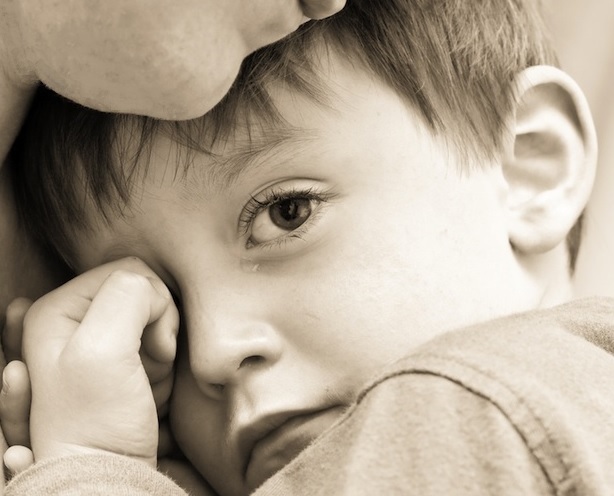 My little Funny Face accidentally killed a butterfly today. Her sweet little heart is broken, poor thing. We’re walking through the stages of mourning together as I use these small (to us adults) losses to equip her with healthy tools for handling the difficult things life will surely bring through the years, as it does to all of us. Whether it’s the death of a butterfly, the loss of a favorite stuffed animal, or another loss that matters to them deeply, guiding children through their uncomfortable and often overwhelming emotions is something parents are often unprepared to handle. Here are the steps we take together when life gets hard and loss becomes a reality to my children:
My little Funny Face accidentally killed a butterfly today. Her sweet little heart is broken, poor thing. We’re walking through the stages of mourning together as I use these small (to us adults) losses to equip her with healthy tools for handling the difficult things life will surely bring through the years, as it does to all of us. Whether it’s the death of a butterfly, the loss of a favorite stuffed animal, or another loss that matters to them deeply, guiding children through their uncomfortable and often overwhelming emotions is something parents are often unprepared to handle. Here are the steps we take together when life gets hard and loss becomes a reality to my children:
1.) Feeling~The first step is simply allowing my children to feel their emotions. If they’re crying, I listen to their cues to know when to offer hugs or if they need some time alone or just someone to sit quietly next to them. If they’re angry, I watch closely to see if they need some directions for a safe outlet such as punching a pillow or going outside to kick a ball or if they are able to just stomp around and get it out that way. If they are unnaturally quiet, I let them know I’m there if they need me and then I leave them alone to sort through their emotions in their own time.
2.) Expressing~The second step is guiding my children to express their feelings in some tangible form. This step begins either when they initiate a conversation about the loss or when I see that their emotions are getting the best of them, indicating that they need some assistance in moving forward. This step may take the form of simply talking through what they are feeling, but typically it includes drawing a picture, making up a song or dictating a poem for me to write down for them, making a memory box, or some combination of each of them.
3.) Refocusing~The third and last step is giving my children ideas about how to move on. It’s often hard for them to figure out how to redirect their thoughts from constantly swirling around their loss. It takes a measure of mental maturity to be able to focus elsewhere when emotions are running high. This is not to say that they should never think about their loss again. I am always open to listening to their feelings and sharing their memories with them. This last step is just gently helping them to consciously shift their attention from what they have lost to what they still have, moving their thoughts from loss to life. This step often takes the form of encouraging them to head outside and play in the mud or climb a tree, or it might be offering to read them a favorite book or play a board game with them or maybe inviting a friend over to play.
While these three steps are in no way exhaustive, the idea behind this process is to simplify the stages of grief in a way that is accessible to parents and understandable to children. And then, when life hits hard and big losses occur such as the loss of a loved one, divorcing parents, etc. having walked through these small losses with our children sets the stage for helping them to work through the harder things while preserving a healthy parent/child connection.
When big life losses do occur, staying in tune with our children and letting them ask questions freely while we work to temper our answers in age appropriate terms is vital. Watching for changes in their behavior helps to give us clues as to what they’re feeling. If they start having trouble sleeping or resisting going to school or having meltdowns, etc. it might be helpful to seek out professional counseling for a brief time. We also need to keep in mind that small children have active imaginations and the line between fantasy and reality is very blurry for them. Death may not impact them much at all if the reality of it doesn’t sink in, or, on the flip side it could have a significant impact and they could begin to imagine all sorts of awful things happening to them or their family or friends. It’s important to let our children lead the way as to how we need to help them cope. Our local library or online at Goodreads or Amazon’s Listopia can also be good resources for age appropriate books on death and grief to share with our children. We do need to be sure to read through them ourselves first to make sure we’re comfortable with how things are presented, though.
Here is a brief, generic ‘script’ that can be used as a starting point for sharing difficult news about a loss with our children:
“I have something to tell you, and it’s a very hard thing. I want you to know that you are safe, and I’m safe, and I’m right here to help you, okay?”
(Give them time to respond.)
“Your (grandpa, aunt, friend, etc.), *name,* died. Do you know what ‘died’ means?”
(Give them time to respond.)
“It means they’re gone to (fill in your belief), and they won’t be coming back.”
(Give them time to respond.)
“It’s okay to be sad or even angry or scared. Those are normal emotions when people die. We are all very sad because we’re going to miss *name.*”
(Give them time to respond.)
“You’ll probably need some time to think about what happened, and you’ll probably have questions. That’s okay. And it’s okay to talk about *name,* too. We all are going to miss *name* and talking about them can help us to remember happy times with them.”
(Give them time to respond.)
“Would you like to make a goodbye card or a memory box? That might help you to feel better.”
Obviously this is a generic script that will need to be adapted based on a child’s responses, but it provides a starting point to open the conversation and begin to walk them through the grieving and healing process. Time does heal, but often it isn’t simply the passage of time that heals, but rather the support and comfort from those with whom we spend that time.
Related posts:
Children in the three to six-year-old age range are beginning to realize that their parents aren’t the all-powerful beings that they once believed them to be. This realization can be very uncomfortable for them, causing them a great deal of unease as they are concurrently beginning to realize that there is a whole, big, wide world beyond their safe, little home, a that the world is full of potential dangers, hazards unknown, and just a lot of really big, scary things. So what is a parent to do with their newly timid little house-mouse? The Age of Fear~Young Children and Anxiety
 Award-winnning author, L.R.Knost, is the founder and director of the children's rights advocacy and family consulting group, Little Hearts/Gentle Parenting Resources, and Editor-in-Chief of Holistic Parenting Magazine. Books by L.R.Knost include Whispers Through Time: Communication Through the Ages and Stages of Childhood ; Two Thousand Kisses a Day: Gentle Parenting Through the Ages and Stages ; The Gentle Parent: Positive, Practical, Effective Discipline ; and Jesus, the Gentle Parent: Gentle Christian Parenting the first four books in the Little Hearts Handbook gentle parenting series, and children’s picture books Petey’s Listening Ears and the soon-to-be-released Grumpykins series.
Award-winnning author, L.R.Knost, is the founder and director of the children's rights advocacy and family consulting group, Little Hearts/Gentle Parenting Resources, and Editor-in-Chief of Holistic Parenting Magazine. Books by L.R.Knost include Whispers Through Time: Communication Through the Ages and Stages of Childhood ; Two Thousand Kisses a Day: Gentle Parenting Through the Ages and Stages ; The Gentle Parent: Positive, Practical, Effective Discipline ; and Jesus, the Gentle Parent: Gentle Christian Parenting the first four books in the Little Hearts Handbook gentle parenting series, and children’s picture books Petey’s Listening Ears and the soon-to-be-released Grumpykins series.
June 1, 2012 | Categories: anxiety, childhood, children, communication, family, fear, gentle parenting, life, loss, middle childhood, preschooler, wisdom, wise council | Tags: childhood, children, communication, family, gentle parenting, loss, middle childhood, preschoolers | Leave A Comment »
[Reprinted from Two Thousand Kisses a Day: Gentle Parenting Through the Ages and Stages by L.R.Knost. Whispers Through Time: Communication Through the Ages and Stages of Childhood and The Gentle Parent: Positive, Practical, Effective Discipline also now available on Amazon and through other major retailers.]
 Your once fearless five-year-old suddenly refuses to leave your side at the park saying, “I’m afraid the birds will eat me,” while eyeing the tiny swallows hopping on the ground as if they’re evil geniuses plotting his demise.
Your once fearless five-year-old suddenly refuses to leave your side at the park saying, “I’m afraid the birds will eat me,” while eyeing the tiny swallows hopping on the ground as if they’re evil geniuses plotting his demise.
Your three-year-old, whom you once found proudly grinning while sitting atop the refrigerator, has abruptly decided the swings are objects of abject terror that will, “Fly me to the ground.” (Translation: I’ll fall off!)
Your six-year-old who has slept like a log in his own bed for years is suddenly resisting bedtime and climbing into your bed with you at 3 am every. single. night.
Your happy little four-year-old suddenly becomes withdrawn and clingy, refusing to play with her playdate friends and wanting to sit in your lap. And, even worse, she’s started sucking her thumb again!
The preschool and early elementary school years are sometimes marred with exaggerated fears, odd anxieties, nightmares, night terrors, and other evidences of insecurity that can make the most confident of parents feel a combination of dismay, frustration, worry, and failure. Regression is a common accompaniment, from pottying accidents to night-waking to thumb-sucking. Often, acting-out behaviors also increase in this time period.
So, what in the world is going on?
No, it’s not an environmental-toxin-induced, super-early-onset of adolescent-hormone-overload. And, normally, it’s not a trauma-reaction to life changes such as moving or starting preschool or school, though those events can exacerbate the issue. (Be aware that these behaviors can, rarely, indicate an anxiety disorder, stress-overload, or abuse. If you suspect any of these things may be causing your child’s behavior, seek a professional evaluation.)
Typically, though, sudden anxiety behaviors in preschool/early elementary aged children are simply another normal stage of development, an indication of cognitive growth. In other words, as odd as it sounds, fear can be a sign of maturity!
Children in the three to six-year-old age range (Keep in mind that this is a rough age estimate. Children are individuals, not pre-programmed robots!) are beginning to realize that their parents aren’t the all-powerful beings that they once believed them to be. This realization can be very uncomfortable for them, causing them a great deal of unease as they are concurrently beginning to realize that there is a whole, big, wide world beyond their safe, little home, and that that world is full of potential dangers, hazards unknown, and just a lot of really big, scary things.
So what is a parent to do with their newly timid little house-mouse?
First, be aware that there is no one-size-fits-all miracle ‘cure.’ You know your child better than anyone else, and being responsive to her unique needs means taking your cues from her as to what may help or hinder her journey through this uncomfortable stage.
That said, here are some ideas that may help:
- Before forcing your child to ‘face his fears,’ consider whether someone throwing a spider on you if you are deathly afraid of spiders or locking you in a closet if you’re claustrophobic would be helpful to you in overcoming your fears. If the answer is ‘NO!’ then honor your child’s feelings and move on to another solution.
- When your child voices her concerns, resist the urge to minimize them. If she says, “I’m afraid of monsters coming in my window,” try not to say, “There’s no such thing as monsters.” Remember, she’s realizing you aren’t all-powerful, and that means you aren’t all-knowing, either! Rather than be reassured by your words, she’ll simply think you don’t know about the monsters and can’t help her and keep her safe. Instead, you can brainstorm ideas together to keep the monsters at bay. While you don’t want to say that monsters actually do exist, you can say something like, “Let’s think of ways to keep you safe. What if daddy throws the monsters away in the trashcans outside and the trashman takes them away?” Don’t be afraid to be seriously silly. In other words, take her fears seriously, but offer silly solutions that offer visuals of the monsters (or whatever the fear is) going away forever.
- Help your child to make a ‘nightmare safe’ out of a shoe box. At night
 before he goes to bed, sit with him and encourage him to put all his scary thoughts in the box for you to take and keep safely away from him while he sleeps. Let him know that if he does have a bad dream, he can come to you even if it’s the middle of the night, and you’ll help him to put the scary dream in the box so he’ll be able to go back to sleep.
before he goes to bed, sit with him and encourage him to put all his scary thoughts in the box for you to take and keep safely away from him while he sleeps. Let him know that if he does have a bad dream, he can come to you even if it’s the middle of the night, and you’ll help him to put the scary dream in the box so he’ll be able to go back to sleep.
- Avoid phrases such as “You’re a big boy now” and “Only babies do that.” Focus instead on encouraging your child to do the things you know he can do. For instance, if he’s usually able to climb the ladder on the slide but gets ‘stuck’ halfway up and asks for help, start by moving near so he knows you are close and willing to help him if needed. Then verbally encourage him, “I know you can do it. I’m here if you need me.” But don’t pressure him. If he gets upset or insists he can’t do it, help him down. Remember, it isn’t really about the slide at all. It’s about seeking reassurance that you can still be trusted to take care of him, that he’s still safe with you.
-
 If the occasional monster in the closet or under the bed needs to be evicted, try reading a book like Go Away, Big Green Monster! and make your own ‘Monster-Away Spray,’ to send all the scary monsters packing. The ones we made didn’t match the colors in the book perfectly because we just used foam stickers and googlie eyes from our craft box and blue spray bottles from the bargain bin at the fabric store, but my girls were thrilled with them. We filled them with water (and added a little spritz of febreeze in my six-year-old’s bottle because, “Monsters can’t STAND flowers!”) and then Daddy and Big Brother took turns pretending to be monsters and ran away squealing from the girls when they got sprayed. Role-playing with children (and just playing with them, period!) is a powerful tool in helping them learn coping skills. Now, a bit of bedtime spritzing in closets and under beds is all it takes to make my girls feel confident that they’ve rousted the beasties so they can sleep in peace!
If the occasional monster in the closet or under the bed needs to be evicted, try reading a book like Go Away, Big Green Monster! and make your own ‘Monster-Away Spray,’ to send all the scary monsters packing. The ones we made didn’t match the colors in the book perfectly because we just used foam stickers and googlie eyes from our craft box and blue spray bottles from the bargain bin at the fabric store, but my girls were thrilled with them. We filled them with water (and added a little spritz of febreeze in my six-year-old’s bottle because, “Monsters can’t STAND flowers!”) and then Daddy and Big Brother took turns pretending to be monsters and ran away squealing from the girls when they got sprayed. Role-playing with children (and just playing with them, period!) is a powerful tool in helping them learn coping skills. Now, a bit of bedtime spritzing in closets and under beds is all it takes to make my girls feel confident that they’ve rousted the beasties so they can sleep in peace!
- If regression is an issue, keep in mind that your child is self-comforting by returning to a time she felt safe. Rather than punishing, ridiculing, bribing, or in other ways trying to ‘control’ the behavior, offer comfort in appropriate ways to demonstrate that she can trust you to meet her comfort/safety needs. This applies to acting-out behaviors, as well. Set boundaries, certainly, and provide plenty of guidance, but remember that punishment tends to push children farther away rather than connecting with them. Since your child is reacting to a feeling of disconnection from you in her new understanding of your non-superhero status, pushing her further away will merely exacerbate the issue, not solve it.
- Just listen. This is the simplest solution to a rather complex problem. Slow down and make time to just take a walk with your child. Sit with him in the evening and watch him color or play a quiet board game with him. Lay with him in his bed for a few minutes before he sleeps and chat about the day. Just the fact of you taking the time to focus on him, to be quiet with him, to enjoy his company, and to reconnect with him will go a long way towards soothing his fears.
- Even if your child isn’t introverted by nature, the following table offers some wonderful tips that translate well into this brief anxiety stage:
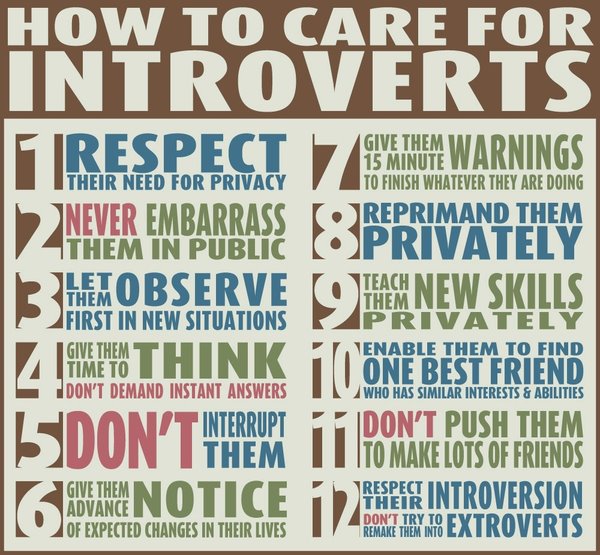
Remember, just like all the other stages of development, this ‘age of fear’ won’t last forever. Staying connected with your child and keeping the communication lines open through the ages and stages of development will help to ease their way as well as keeping your relationship strong and healthy.
Related posts:
Toddlers, Tantrums, and Time-Ins, Oh My!
Testing the Boundaries~What’s A Parent To Do?
To a Toddler Sharing is a 4 Letter Word~MINE!
Babes and Boundaries~A Gentle Parenting Perspective
Your Baby isn’t Trying to Annoy You; He’s Trying to Communicate!
 Award-winnning author, L.R.Knost, is the founder and director of the children's rights advocacy and family consulting group, Little Hearts/Gentle Parenting Resources, and Editor-in-Chief of Holistic Parenting Magazine. Books by L.R.Knost include Whispers Through Time: Communication Through the Ages and Stages of Childhood ; Two Thousand Kisses a Day: Gentle Parenting Through the Ages and Stages ; The Gentle Parent: Positive, Practical, Effective Discipline ; and Jesus, the Gentle Parent: Gentle Christian Parenting the first four books in the Little Hearts Handbook gentle parenting series, and children’s picture books Petey’s Listening Ears and the soon-to-be-released Grumpykins series.
Award-winnning author, L.R.Knost, is the founder and director of the children's rights advocacy and family consulting group, Little Hearts/Gentle Parenting Resources, and Editor-in-Chief of Holistic Parenting Magazine. Books by L.R.Knost include Whispers Through Time: Communication Through the Ages and Stages of Childhood ; Two Thousand Kisses a Day: Gentle Parenting Through the Ages and Stages ; The Gentle Parent: Positive, Practical, Effective Discipline ; and Jesus, the Gentle Parent: Gentle Christian Parenting the first four books in the Little Hearts Handbook gentle parenting series, and children’s picture books Petey’s Listening Ears and the soon-to-be-released Grumpykins series.
May 9, 2012 | Categories: anxiety, childhood, children, communication, fear, gentle discipline, gentle parenting, positive parenting, preschooler | Tags: childhood, children, communication, gentle discipline, gentle parenting, positive parenting, preschoolers | 9 Comments »
 Oh, the toddler years, those delightful days when little ones begin to discover that they are, indeed, separate individuals from their parents and begin to test the waters to see how far out to sea their little boats can take them when they’ve got a full head of steam. This is the age when parents begin to wonder how in the world to tether their little steamboats to the docks or scuttle them in shallow waters to slow them down.
Oh, the toddler years, those delightful days when little ones begin to discover that they are, indeed, separate individuals from their parents and begin to test the waters to see how far out to sea their little boats can take them when they’ve got a full head of steam. This is the age when parents begin to wonder how in the world to tether their little steamboats to the docks or scuttle them in shallow waters to slow them down. Award-winnning author, L.R.Knost, is the founder and director of the children's rights advocacy and family consulting group, Little Hearts/Gentle Parenting Resources, and Editor-in-Chief of Holistic Parenting Magazine. Books by L.R.Knost include Whispers Through Time: Communication Through the Ages and Stages of Childhood ; Two Thousand Kisses a Day: Gentle Parenting Through the Ages and Stages ; The Gentle Parent: Positive, Practical, Effective Discipline ; and Jesus, the Gentle Parent: Gentle Christian Parenting the first four books in the Little Hearts Handbook gentle parenting series, and children’s picture books Petey’s Listening Ears and the soon-to-be-released Grumpykins series.
Award-winnning author, L.R.Knost, is the founder and director of the children's rights advocacy and family consulting group, Little Hearts/Gentle Parenting Resources, and Editor-in-Chief of Holistic Parenting Magazine. Books by L.R.Knost include Whispers Through Time: Communication Through the Ages and Stages of Childhood ; Two Thousand Kisses a Day: Gentle Parenting Through the Ages and Stages ; The Gentle Parent: Positive, Practical, Effective Discipline ; and Jesus, the Gentle Parent: Gentle Christian Parenting the first four books in the Little Hearts Handbook gentle parenting series, and children’s picture books Petey’s Listening Ears and the soon-to-be-released Grumpykins series.
 A common stage that can start around age 2 but typically peaks by age 4 is the passive aggressive communication of negative feelings. This stage occurs on its own as a normal milestone because the child needs to develop verbal skills and emotional intelligence. But, for some children, the stage can be especially difficult due to various factors.
A common stage that can start around age 2 but typically peaks by age 4 is the passive aggressive communication of negative feelings. This stage occurs on its own as a normal milestone because the child needs to develop verbal skills and emotional intelligence. But, for some children, the stage can be especially difficult due to various factors. Award-winnning author, L.R.Knost, is the founder and director of the children's rights advocacy and family consulting group, Little Hearts/Gentle Parenting Resources, and Editor-in-Chief of Holistic Parenting Magazine. Books by L.R.Knost include Whispers Through Time: Communication Through the Ages and Stages of Childhood ; Two Thousand Kisses a Day: Gentle Parenting Through the Ages and Stages ; The Gentle Parent: Positive, Practical, Effective Discipline ; and Jesus, the Gentle Parent: Gentle Christian Parenting the first four books in the Little Hearts Handbook gentle parenting series, and children’s picture books Petey’s Listening Ears and the soon-to-be-released Grumpykins series.
Award-winnning author, L.R.Knost, is the founder and director of the children's rights advocacy and family consulting group, Little Hearts/Gentle Parenting Resources, and Editor-in-Chief of Holistic Parenting Magazine. Books by L.R.Knost include Whispers Through Time: Communication Through the Ages and Stages of Childhood ; Two Thousand Kisses a Day: Gentle Parenting Through the Ages and Stages ; The Gentle Parent: Positive, Practical, Effective Discipline ; and Jesus, the Gentle Parent: Gentle Christian Parenting the first four books in the Little Hearts Handbook gentle parenting series, and children’s picture books Petey’s Listening Ears and the soon-to-be-released Grumpykins series.

 Award-winnning author, L.R.Knost, is the founder and director of the children's rights advocacy and family consulting group, Little Hearts/Gentle Parenting Resources, and Editor-in-Chief of Holistic Parenting Magazine. Books by L.R.Knost include Whispers Through Time: Communication Through the Ages and Stages of Childhood ; Two Thousand Kisses a Day: Gentle Parenting Through the Ages and Stages ; The Gentle Parent: Positive, Practical, Effective Discipline ; and Jesus, the Gentle Parent: Gentle Christian Parenting the first four books in the Little Hearts Handbook gentle parenting series, and children’s picture books Petey’s Listening Ears and the soon-to-be-released Grumpykins series.
Award-winnning author, L.R.Knost, is the founder and director of the children's rights advocacy and family consulting group, Little Hearts/Gentle Parenting Resources, and Editor-in-Chief of Holistic Parenting Magazine. Books by L.R.Knost include Whispers Through Time: Communication Through the Ages and Stages of Childhood ; Two Thousand Kisses a Day: Gentle Parenting Through the Ages and Stages ; The Gentle Parent: Positive, Practical, Effective Discipline ; and Jesus, the Gentle Parent: Gentle Christian Parenting the first four books in the Little Hearts Handbook gentle parenting series, and children’s picture books Petey’s Listening Ears and the soon-to-be-released Grumpykins series.
 What do you get when you cross a curious toddler with a Christmas tree covered with glittering, dangling ‘toys’ and enticing, shiny lights? At the very least, a season of toddler chasing and redirecting, and at the worst a season of shattered-glass hazards and tree-scaling, toppling nightmares. So what’s a parent to do? Must we scrap the tree so we can have a merry Christmas while we have little ones in the house? Not at all!
What do you get when you cross a curious toddler with a Christmas tree covered with glittering, dangling ‘toys’ and enticing, shiny lights? At the very least, a season of toddler chasing and redirecting, and at the worst a season of shattered-glass hazards and tree-scaling, toppling nightmares. So what’s a parent to do? Must we scrap the tree so we can have a merry Christmas while we have little ones in the house? Not at all! 1.) A Christmas tree plopped down right in the middle of a child’s playspace (i.e. family room, living room, den) is just too much temptation for any little person, so one solution is to place the tree in a lesser-used room such as a study or office or even a covered porch where the tree can be seen but is less accessible to little explorers.
1.) A Christmas tree plopped down right in the middle of a child’s playspace (i.e. family room, living room, den) is just too much temptation for any little person, so one solution is to place the tree in a lesser-used room such as a study or office or even a covered porch where the tree can be seen but is less accessible to little explorers. alternatives) tied to the tree with ribbons instead of metal hooks (choking hazard!) are the solution to our current little spelunker who loves to crawl under the Christmas tree and lay looking up at the sparkling lights from her little hidey-hole.
alternatives) tied to the tree with ribbons instead of metal hooks (choking hazard!) are the solution to our current little spelunker who loves to crawl under the Christmas tree and lay looking up at the sparkling lights from her little hidey-hole. 15.) Unless you like wrapping presents over and over and…well, you get the picture, avoid setting wrapped packages out under the tree if the tree is accessible to small children. Keeping your expectations in line with your child’s developmental stage is a key element to avoiding conflict in your parent/child relationship and making your holidays less stressful and more enjoyable!
15.) Unless you like wrapping presents over and over and…well, you get the picture, avoid setting wrapped packages out under the tree if the tree is accessible to small children. Keeping your expectations in line with your child’s developmental stage is a key element to avoiding conflict in your parent/child relationship and making your holidays less stressful and more enjoyable! park/mall/etc., we need to allow them to set limits they are comfortable with when it comes to physical contact and interaction with the ‘strangers’ in our homes, as well.
park/mall/etc., we need to allow them to set limits they are comfortable with when it comes to physical contact and interaction with the ‘strangers’ in our homes, as well. Award-winnning author, L.R.Knost, is the founder and director of the children's rights advocacy and family consulting group, Little Hearts/Gentle Parenting Resources, and Editor-in-Chief of Holistic Parenting Magazine. Books by L.R.Knost include Whispers Through Time: Communication Through the Ages and Stages of Childhood ; Two Thousand Kisses a Day: Gentle Parenting Through the Ages and Stages ; The Gentle Parent: Positive, Practical, Effective Discipline ; and Jesus, the Gentle Parent: Gentle Christian Parenting the first four books in the Little Hearts Handbook gentle parenting series, and children’s picture books Petey’s Listening Ears and the soon-to-be-released Grumpykins series.
Award-winnning author, L.R.Knost, is the founder and director of the children's rights advocacy and family consulting group, Little Hearts/Gentle Parenting Resources, and Editor-in-Chief of Holistic Parenting Magazine. Books by L.R.Knost include Whispers Through Time: Communication Through the Ages and Stages of Childhood ; Two Thousand Kisses a Day: Gentle Parenting Through the Ages and Stages ; The Gentle Parent: Positive, Practical, Effective Discipline ; and Jesus, the Gentle Parent: Gentle Christian Parenting the first four books in the Little Hearts Handbook gentle parenting series, and children’s picture books Petey’s Listening Ears and the soon-to-be-released Grumpykins series.
 Homeschooling a unique learner can be challenging simply because they don’t get the benefit of access to testing and professional support without a lot of initiative, research, phone calls, and door-knocking on your part. But the trade-off is the freedom to tailor your teaching and learning environment to your child’s needs, and that is of incredible value when educating a unique learner.
Homeschooling a unique learner can be challenging simply because they don’t get the benefit of access to testing and professional support without a lot of initiative, research, phone calls, and door-knocking on your part. But the trade-off is the freedom to tailor your teaching and learning environment to your child’s needs, and that is of incredible value when educating a unique learner. unique learner sit in a comfortable seat while pedaling. The cross-over action of pedaling also has an organizing effect on the brain, and, if used while reading or playing video games (Video games can be great exercises for eye-tracking if you choose the right ones!) can actually increase the speed and effectiveness of learning.
unique learner sit in a comfortable seat while pedaling. The cross-over action of pedaling also has an organizing effect on the brain, and, if used while reading or playing video games (Video games can be great exercises for eye-tracking if you choose the right ones!) can actually increase the speed and effectiveness of learning.


 Award-winnning author, L.R.Knost, is the founder and director of the children's rights advocacy and family consulting group, Little Hearts/Gentle Parenting Resources, and Editor-in-Chief of Holistic Parenting Magazine. Books by L.R.Knost include Whispers Through Time: Communication Through the Ages and Stages of Childhood ; Two Thousand Kisses a Day: Gentle Parenting Through the Ages and Stages ; The Gentle Parent: Positive, Practical, Effective Discipline ; and Jesus, the Gentle Parent: Gentle Christian Parenting the first four books in the Little Hearts Handbook gentle parenting series, and children’s picture books Petey’s Listening Ears and the soon-to-be-released Grumpykins series.
Award-winnning author, L.R.Knost, is the founder and director of the children's rights advocacy and family consulting group, Little Hearts/Gentle Parenting Resources, and Editor-in-Chief of Holistic Parenting Magazine. Books by L.R.Knost include Whispers Through Time: Communication Through the Ages and Stages of Childhood ; Two Thousand Kisses a Day: Gentle Parenting Through the Ages and Stages ; The Gentle Parent: Positive, Practical, Effective Discipline ; and Jesus, the Gentle Parent: Gentle Christian Parenting the first four books in the Little Hearts Handbook gentle parenting series, and children’s picture books Petey’s Listening Ears and the soon-to-be-released Grumpykins series.
 Toddlers and preschoolers are still in the early stages of learning to communicate verbally. Add to that the fact that they have little-to-no impulse control and very immature social skills, and you’ve got a recipe for an instinctive physical response (i.e. hitting, kicking, biting, hair pulling, throwing things, etc.) to situations in which they are frustrated, angry, scared, or just tired and out-of-sorts.
Toddlers and preschoolers are still in the early stages of learning to communicate verbally. Add to that the fact that they have little-to-no impulse control and very immature social skills, and you’ve got a recipe for an instinctive physical response (i.e. hitting, kicking, biting, hair pulling, throwing things, etc.) to situations in which they are frustrated, angry, scared, or just tired and out-of-sorts. Award-winnning author, L.R.Knost, is the founder and director of the children's rights advocacy and family consulting group, Little Hearts/Gentle Parenting Resources, and Editor-in-Chief of Holistic Parenting Magazine. Books by L.R.Knost include Whispers Through Time: Communication Through the Ages and Stages of Childhood ; Two Thousand Kisses a Day: Gentle Parenting Through the Ages and Stages ; The Gentle Parent: Positive, Practical, Effective Discipline ; and Jesus, the Gentle Parent: Gentle Christian Parenting the first four books in the Little Hearts Handbook gentle parenting series, and children’s picture books Petey’s Listening Ears and the soon-to-be-released Grumpykins series.
Award-winnning author, L.R.Knost, is the founder and director of the children's rights advocacy and family consulting group, Little Hearts/Gentle Parenting Resources, and Editor-in-Chief of Holistic Parenting Magazine. Books by L.R.Knost include Whispers Through Time: Communication Through the Ages and Stages of Childhood ; Two Thousand Kisses a Day: Gentle Parenting Through the Ages and Stages ; The Gentle Parent: Positive, Practical, Effective Discipline ; and Jesus, the Gentle Parent: Gentle Christian Parenting the first four books in the Little Hearts Handbook gentle parenting series, and children’s picture books Petey’s Listening Ears and the soon-to-be-released Grumpykins series.

 My little Funny Face accidentally killed a butterfly today. Her sweet little heart is broken, poor thing. We’re walking through the stages of mourning together as I use these small (to us adults) losses to equip her with healthy tools for handling the difficult things life will surely bring through the years, as it does to all of us. Whether it’s the death of a butterfly, the loss of a favorite stuffed animal, or another loss that matters to them deeply, guiding children through their uncomfortable and often overwhelming emotions is something parents are often unprepared to handle. Here are the steps we take together when life gets hard and loss becomes a reality to my children:
My little Funny Face accidentally killed a butterfly today. Her sweet little heart is broken, poor thing. We’re walking through the stages of mourning together as I use these small (to us adults) losses to equip her with healthy tools for handling the difficult things life will surely bring through the years, as it does to all of us. Whether it’s the death of a butterfly, the loss of a favorite stuffed animal, or another loss that matters to them deeply, guiding children through their uncomfortable and often overwhelming emotions is something parents are often unprepared to handle. Here are the steps we take together when life gets hard and loss becomes a reality to my children: Award-winnning author, L.R.Knost, is the founder and director of the children's rights advocacy and family consulting group, Little Hearts/Gentle Parenting Resources, and Editor-in-Chief of Holistic Parenting Magazine. Books by L.R.Knost include Whispers Through Time: Communication Through the Ages and Stages of Childhood ; Two Thousand Kisses a Day: Gentle Parenting Through the Ages and Stages ; The Gentle Parent: Positive, Practical, Effective Discipline ; and Jesus, the Gentle Parent: Gentle Christian Parenting the first four books in the Little Hearts Handbook gentle parenting series, and children’s picture books Petey’s Listening Ears and the soon-to-be-released Grumpykins series.
Award-winnning author, L.R.Knost, is the founder and director of the children's rights advocacy and family consulting group, Little Hearts/Gentle Parenting Resources, and Editor-in-Chief of Holistic Parenting Magazine. Books by L.R.Knost include Whispers Through Time: Communication Through the Ages and Stages of Childhood ; Two Thousand Kisses a Day: Gentle Parenting Through the Ages and Stages ; The Gentle Parent: Positive, Practical, Effective Discipline ; and Jesus, the Gentle Parent: Gentle Christian Parenting the first four books in the Little Hearts Handbook gentle parenting series, and children’s picture books Petey’s Listening Ears and the soon-to-be-released Grumpykins series.
Your once fearless five-year-old suddenly refuses to leave your side at the park saying, “I’m afraid the birds will eat me,” while eyeing the tiny swallows hopping on the ground as if they’re evil geniuses plotting his demise.
 before he goes to bed, sit with him and encourage him to put all his scary thoughts in the box for you to take and keep safely away from him while he sleeps. Let him know that if he does have a bad dream, he can come to you even if it’s the middle of the night, and you’ll help him to put the scary dream in the box so he’ll be able to go back to sleep.
before he goes to bed, sit with him and encourage him to put all his scary thoughts in the box for you to take and keep safely away from him while he sleeps. Let him know that if he does have a bad dream, he can come to you even if it’s the middle of the night, and you’ll help him to put the scary dream in the box so he’ll be able to go back to sleep. If the occasional monster in the closet or under the bed needs to be evicted, try reading a book like Go Away, Big Green Monster! and make your own ‘Monster-Away Spray,’ to send all the scary monsters packing. The ones we made didn’t match the colors in the book perfectly because we just used foam stickers and googlie eyes from our craft box and blue spray bottles from the bargain bin at the fabric store, but my girls were thrilled with them. We filled them with water (and added a little spritz of febreeze in my six-year-old’s bottle because, “Monsters can’t STAND flowers!”) and then Daddy and Big Brother took turns pretending to be monsters and ran away squealing from the girls when they got sprayed. Role-playing with children (and just playing with them, period!) is a powerful tool in helping them learn coping skills. Now, a bit of bedtime spritzing in closets and under beds is all it takes to make my girls feel confident that they’ve rousted the beasties so they can sleep in peace!
If the occasional monster in the closet or under the bed needs to be evicted, try reading a book like Go Away, Big Green Monster! and make your own ‘Monster-Away Spray,’ to send all the scary monsters packing. The ones we made didn’t match the colors in the book perfectly because we just used foam stickers and googlie eyes from our craft box and blue spray bottles from the bargain bin at the fabric store, but my girls were thrilled with them. We filled them with water (and added a little spritz of febreeze in my six-year-old’s bottle because, “Monsters can’t STAND flowers!”) and then Daddy and Big Brother took turns pretending to be monsters and ran away squealing from the girls when they got sprayed. Role-playing with children (and just playing with them, period!) is a powerful tool in helping them learn coping skills. Now, a bit of bedtime spritzing in closets and under beds is all it takes to make my girls feel confident that they’ve rousted the beasties so they can sleep in peace!
 Award-winnning author, L.R.Knost, is the founder and director of the children's rights advocacy and family consulting group, Little Hearts/Gentle Parenting Resources, and Editor-in-Chief of Holistic Parenting Magazine. Books by L.R.Knost include Whispers Through Time: Communication Through the Ages and Stages of Childhood ; Two Thousand Kisses a Day: Gentle Parenting Through the Ages and Stages ; The Gentle Parent: Positive, Practical, Effective Discipline ; and Jesus, the Gentle Parent: Gentle Christian Parenting the first four books in the Little Hearts Handbook gentle parenting series, and children’s picture books Petey’s Listening Ears and the soon-to-be-released Grumpykins series.
Award-winnning author, L.R.Knost, is the founder and director of the children's rights advocacy and family consulting group, Little Hearts/Gentle Parenting Resources, and Editor-in-Chief of Holistic Parenting Magazine. Books by L.R.Knost include Whispers Through Time: Communication Through the Ages and Stages of Childhood ; Two Thousand Kisses a Day: Gentle Parenting Through the Ages and Stages ; The Gentle Parent: Positive, Practical, Effective Discipline ; and Jesus, the Gentle Parent: Gentle Christian Parenting the first four books in the Little Hearts Handbook gentle parenting series, and children’s picture books Petey’s Listening Ears and the soon-to-be-released Grumpykins series.


 What do I mean? Well, I mean that night waking in infancy does not predict night waking at later ages, at least based on a very comprehensive, longitudinal study out of Switzerland
What do I mean? Well, I mean that night waking in infancy does not predict night waking at later ages, at least based on a very comprehensive, longitudinal study out of Switzerland “Bedtime. Go grab your toothbrush from the suitcase, okay?”
“Bedtime. Go grab your toothbrush from the suitcase, okay?” that must be purged? At what point did “defeating” a child so that they are “totally broken” become the goal of Christian parenting?
that must be purged? At what point did “defeating” a child so that they are “totally broken” become the goal of Christian parenting?
 legends, clichés and adages, and weaving them into unique or humorous settings.
legends, clichés and adages, and weaving them into unique or humorous settings. [Reprinted from
[Reprinted from 




 In this digital era not only is the world available literally at our fingertips, but a whole new world has opened for predators, pedophiles, perverts, and porn purveyors to assault our children. From predators posing as children to draw children into online relationships and then lure them into real-life danger to pedophiles using the power and anonymity of the internet to traffic in child pornography, our children are at risk in ways that are increasingly difficult to monitor, filter, and protect them from. We are advised to supervise their online activities, but how are we to know that little twelve-year-old Patsy from piano class is actually fifty-year-old Patrick from prison or that fourteen-year-old Joey from the local gym is actually forty-eight-year-old Jimmy from the local jail?
In this digital era not only is the world available literally at our fingertips, but a whole new world has opened for predators, pedophiles, perverts, and porn purveyors to assault our children. From predators posing as children to draw children into online relationships and then lure them into real-life danger to pedophiles using the power and anonymity of the internet to traffic in child pornography, our children are at risk in ways that are increasingly difficult to monitor, filter, and protect them from. We are advised to supervise their online activities, but how are we to know that little twelve-year-old Patsy from piano class is actually fifty-year-old Patrick from prison or that fourteen-year-old Joey from the local gym is actually forty-eight-year-old Jimmy from the local jail? Capri points at the front door every morning and says, “Daddy, go!” Her daddy feels a bit rejected, especially on the weekends when he doesn’t have to go to work and his little girl cries because he won’t leave!
Capri points at the front door every morning and says, “Daddy, go!” Her daddy feels a bit rejected, especially on the weekends when he doesn’t have to go to work and his little girl cries because he won’t leave!  Pregnancy is a time of introspection, excitement, and, often, anxiety for most new mamas. When those new mamas also have other small children at home, that anxiety can become overwhelming as they worry about how they’ll cope with more than one child and how the current little loves of their life will cope with a new sibling. While these are very valid concerns, there are steps you can take to prepare your child for a new sibling and help them to adjust when the new baby arrives that will also help you to cope with life as a mama of more than one little blessing.
Pregnancy is a time of introspection, excitement, and, often, anxiety for most new mamas. When those new mamas also have other small children at home, that anxiety can become overwhelming as they worry about how they’ll cope with more than one child and how the current little loves of their life will cope with a new sibling. While these are very valid concerns, there are steps you can take to prepare your child for a new sibling and help them to adjust when the new baby arrives that will also help you to cope with life as a mama of more than one little blessing. Related posts:
Related posts: “She won’t share!”
“She won’t share!” 







